A Review of THz Modulators with Dynamic Tunable Metasurfaces
Abstract
1. Introduction
2. Conventional Bulk Semiconductor Metasurface
2.1. Electrical Controlled THz Modulator
2.2. Photo-Induced THz Modulator
2.3. Coding Metasurface THz Modulator
3. Two-Dimensional Electron Gas Metasurface
4. Graphene and 2D Material Metasurfaces
Other 2D Materials
5. Vanadium Dioxide Metasurface
6. Liquid Crystal Metasurface
7. Superconducting Metasurface
7.1. High-Tc Superconductors with a Dynamic Tunable Metasurface
7.2. Low-Tc Superconductors with a Dynamic Tunable Metasurface
8. Spintronics Metasurface
9. Conclusions
Author Contributions
Funding
Acknowledgments
Conflicts of Interest
References
- Rahm, M.; Li, J.S.; Padilla, W.J. THz wave modulators: A brief review on different modulation techniques. J. Infrared Millim. Terahertz Waves 2013, 34, 1–27. [Google Scholar] [CrossRef]
- Li, A.B.; Singh, S.; Sievenpiper, D. Metasurfaces and their applications. Nanophotonics 2018, 7, 989–1011. [Google Scholar] [CrossRef]
- Yu, N.F.; Genevet, P.; Kats, M.A.; Aieta, F.; Tetienne, J.P.; Capasso, F.; Gaburro, Z. Light propagation with phase discontinuities: Generalized laws of reflection and refraction. Science 2011, 334, 333–337. [Google Scholar] [CrossRef] [PubMed]
- Genevet, P.; Yu, N.F.; Aieta, F.; Lin, J.; Kats, M.A.; Blanchard, R.; Scully, M.O.; Gaburro, Z.; Capasso, F. Ultra-thin plasmonic optical vortex plate based on phase discontinuities. Appl. Phys. Lett. 2012, 100, 013101. [Google Scholar] [CrossRef]
- Yu, N.F.; Aieta, F.; Genevet, P.; Kats, M.A.; Gaburro, Z.; Capasso, F. A broadband, background-free quarter-wave plate based on plasmonic metasurfaces. Nano Lett. 2012, 12, 6328–6333. [Google Scholar] [CrossRef] [PubMed]
- Huang, W.X.; Zhang, Y.; Tang, X.M.; Cai, L.S.; Zhao, J.W.; Zhou, L.; Wang, Q.J.; Huang, C.P.; Zhu, Y.Y. Optical properties of a planar metamaterial with chiral symmetry breaking. Opt. Lett. 2011, 36, 3359–3361. [Google Scholar] [CrossRef] [PubMed]
- Shirmanesh, G.K.; Sokhoyan, R.; Pala, R.A.; Atwater, H.A. Dual-gated active metasurface at 1550 nm with wide (> 300°) phase tunability. Nano Lett. 2018, 18, 2957–2963. [Google Scholar] [CrossRef]
- Hum, S.V.; Okoniewski, M.; Davies, R.J. Modeling and design of electronically tunable reflectarrays. IEEE Trans. Antennas Propag. 2007, 55, 2200–2210. [Google Scholar] [CrossRef]
- Chen, H.-T.; Padilla, W.J.; Cich, M.J.; Azad, A.K.; Averitt, R.D.; Taylor, A.J. A metamaterial solid-state terahertz phase modulator. Nat. Photonics 2009, 3, 148–151. [Google Scholar] [CrossRef]
- Isic, G.; Sinatkas, G.; Zografopoulos, D.C.; Vasic, B.; Ferraro, A.; Beccherelli, R.; Kriezis, E.E.; Belic, M. Electrically tunable metal-semiconductor-metal terahertz metasurface modulators. IEEE J. Sel. Top. Quant. 2019, 25, 8. [Google Scholar] [CrossRef]
- Shen, X.P.; Cui, T.J. Photoexcited broadband redshift switch and strength modulation of terahertz metamaterial absorber. J. Opt. 2012, 14, 114012. [Google Scholar] [CrossRef]
- Jessop, D.S.; Kindness, S.J.; Xiao, L.; Braeuninger-Weimer, P.; Lin, H.; Ren, Y.; Ren, C.X.; Hofmann, S.; Zeitler, J.A.; Beere, H.E.; et al. Graphene based plasmonic terahertz amplitude modulator operating above 100 MHz. Appl. Phys. Lett. 2016, 108, 171101. [Google Scholar] [CrossRef]
- Srivastava, Y.K.; Chaturvedi, A.; Manjappa, M.; Kumar, A.; Dayal, G.; Kloc, C.; Singh, R. MoS2 for ultrafast all-optical switching and modulation of THz fano metaphotonic devices. Adv. Opt. Mater. 2017, 5, 1700762. [Google Scholar] [CrossRef]
- Zhang, Y.; Qiao, S.; Liang, S.; Wu, Z.; Yang, Z.; Feng, Z.; Sun, H.; Zhou, Y.; Sun, L.; Chen, Z.; et al. Gbps terahertz external modulator based on a composite metamaterial with a double-channel heterostructure. Nano Lett. 2015, 15, 3501–3506. [Google Scholar] [CrossRef] [PubMed]
- Zhou, Z.; Wang, S.; Yu, Y.; Chen, Y.; Feng, L. High performance metamaterials-high electron mobility transistors integrated terahertz modulator. Opt. Express 2017, 25, 17832–17840. [Google Scholar] [CrossRef] [PubMed]
- Zhang, Y.X.; Qiao, S.; Sun, L.L.; Shi, Q.W.; Huang, W.X.; Li, L.; Yang, Z.Q. Photoinduced active terahertz metamaterials with nanostructured vanadium dioxide film deposited by sol-gel method. Opt. Express 2014, 22, 11070–11078. [Google Scholar] [CrossRef] [PubMed]
- Isic, G.; Vasic, B.; Zografopoulos, D.C.; Beccherelli, R.; Gajic, R. Electrically tunable critically coupled terahertz metamaterial absorber based on nematic liquid crystals. Phys. Rev. Appl. 2015, 3, 8. [Google Scholar] [CrossRef]
- Wang, L.; Ge, S.; Hu, W.; Nakajima, M.; Lu, Y. Graphene-assisted high-efficiency liquid crystal tunable terahertz metamaterial absorber. Opt. Express 2017, 25, 23873–23879. [Google Scholar] [CrossRef] [PubMed]
- Srivastava, Y.K.; Manjappa, M.; Cong, L.Q.; Krishnamoorthy, H.N.S.; Savinov, V.; Pitchappa, P.; Singh, R. A superconducting dual-channel photonic switch. Adv. Mater. 2018, 30, 1801257. [Google Scholar] [CrossRef]
- Li, C.; Wu, J.B.; Jiang, S.L.; Su, R.F.; Zhang, C.H.; Jiang, C.T.; Zhou, G.C.; Jin, B.B.; Kang, L.; Xu, W.W.; et al. Electrical dynamic modulation of THz radiation based on superconducting metamaterials. Appl. Phys. Lett. 2017, 111. [Google Scholar] [CrossRef]
- Zhou, S.Y.; Ji, J.; Tian, Y.; Ling, F.; Yu, W.F. Optically tuned dielectric property of barium titanate thin film by THz spectroscopy. Opt. Mater. 2017, 73, 623–627. [Google Scholar] [CrossRef]
- Manceau, J.M.; Shen, N.H.; Kafesaki, M.; Soukoulis, C.M.; Tzortzakis, S. Dynamic response of metamaterials in the terahertz regime: Blueshift tunability and broadband phase modulation. Appl. Phys. Lett. 2010, 96, 021111. [Google Scholar] [CrossRef]
- Lee, S.H.; Choi, M.; Kim, T.T.; Lee, S.; Liu, M.; Yin, X.; Choi, H.K.; Lee, S.S.; Choi, C.G.; Choi, S.Y.; et al. Switching terahertz waves with gate-controlled active graphene metamaterials. Nat. Mater. 2012, 11, 936–941. [Google Scholar] [CrossRef] [PubMed]
- Arezoomandan, S.; Yang, K.; Sensale-Rodriguez, B. Graphene-based electrically reconfigurable deep-subwavelength metamaterials for active control of THz light propagation. Appl. Phys. A-Mater. 2014, 117, 423–426. [Google Scholar] [CrossRef]
- Zhang, Y.; Zhao, Y.; Liang, S.; Zhang, B.; Wang, L.; Zhou, T.; Kou, W.; Lan, F.; Zeng, H.; Han, J.; et al. Large phase modulation of THz wave via an enhanced resonant active HEMT metasurface. Nanophotonics 2018, 8, 153–170. [Google Scholar] [CrossRef]
- Hashemi, M.R.M.; Yang, S.H.; Wang, T.Y.; Sepulveda, N.; Jarrahi, M. Electronically-controlled beam-steering through vanadium dioxide metasurfaces. Sci. Rep. 2016, 6, 35439. [Google Scholar] [CrossRef]
- Zhao, Y.C.; Zhang, Y.X.; Shi, Q.W.; Liang, S.X.; Huang, W.X.; Kou, W.; Yang, Z.Q. Dynamic photoinduced controlling of the large phase shift of terahertz waves via vanadium dioxide coupling nanostructures. ACS Photonics 2018, 5, 3040–3050. [Google Scholar] [CrossRef]
- Ji, Y.Y.; Fan, F.; Chen, M.; Yang, L.; Chang, S.J. Terahertz artificial birefringence and tunable phase shifter based on dielectric metasurface with compound lattice. Opt. Express 2017, 25, 11405–11413. [Google Scholar] [CrossRef]
- Liu, F.; Pitilakis, A.; Mirmoosa, M.S.; Tsilipakos, O.; Wang, X.C.; Tasolamprou, A.C.; Abadal, S.; Cabellos-Aparicio, A.; Alarcon, E.; Liaskos, C.; et al. Programmable metasurfaces: State of the art and prospects. In Proceedings of the 2018 IEEE International Symposium on Circuits and Systems, Firenze, Italy, 27–30 May 2018. [Google Scholar]
- Cui, T.; Bai, B.F.; Sun, H.B. Tunable metasurfaces based on active materials. Adv. Funct. Mater. 2019, 29, 14. [Google Scholar] [CrossRef]
- Degl’Innocenti, R.; Kindness, S.J.; Beere, H.E.; Ritchie, D.A. All-integrated terahertz modulators. Nanophotonics 2018, 7, 127–144. [Google Scholar] [CrossRef]
- Ding, F.; Yang, Y.Q.; Deshpande, R.A.; Bozhevolnyi, S.I. A review of gap-surface plasmon metasurfaces: Fundamentals and applications. Nanophotonics 2018, 7, 1129–1156. [Google Scholar] [CrossRef]
- Cheng, J.R.; Fan, F.; Chang, S.J. Recent progress on graphene-functionalized metasurfaces for tunable Phase and polarization control. Nanomaterials 2019, 9, 398. [Google Scholar] [CrossRef] [PubMed]
- Chen, H.T.; Padilla, W.J.; Zide, J.M.; Gossard, A.C.; Taylor, A.J.; Averitt, R.D. Active terahertz metamaterial devices. Nature 2006, 444, 597–600. [Google Scholar] [CrossRef] [PubMed]
- Paul, O.; Imhof, C.; Lagel, B.; Wolff, S.; Heinrich, J.; Hofling, S.; Forchel, A.; Zengerle, R.; Beigang, R.; Rahm, M. Polarization-independent active metamaterial for high-frequency terahertz modulation. Opt. Express 2009, 17, 819–827. [Google Scholar] [CrossRef] [PubMed]
- Jun, Y.C.; Gonzales, E.; Reno, J.L.; Shaner, E.A.; Gabbay, A.; Brener, I. Active tuning of mid-infrared metamaterials by electrical control of carrier densities. Opt. Express 2012, 20, 1903–1911. [Google Scholar] [CrossRef] [PubMed]
- Liao, M.L.; Cong, J.W.; Zhang, X.; Cui, Y.P. Development of an electrically controlled terahertz-wave modulator. J. Mod. Opt. 2013, 60, 1690–1695. [Google Scholar] [CrossRef]
- Karl, N.; Reichel, K.; Chen, H.T.; Taylor, A.J.; Brener, I.; Benz, A.; Reno, J.L.; Mendis, R.; Mittleman, D.M. An electrically driven terahertz metamaterial diffractive modulator with more than 20 dB of dynamic range. Appl. Phys. Lett. 2014, 104. [Google Scholar] [CrossRef]
- Keiser, G.R.; Karl, N.; Liu, P.Q.; Tulloss, C.; Chen, H.T.; Taylor, A.J.; Brener, I.; Reno, J.L.; Mittleman, D.M. Nonlinear terahertz metamaterials with active electrical control. Appl. Phys. Lett. 2017, 111, 121101. [Google Scholar] [CrossRef]
- Bai, Y.; Chen, K.J.; Bu, T.; Zhuang, S.L. An electrically tunable terahertz metamaterial modulator with two independent channels. J. Appl. Phys. 2016, 119, 124505. [Google Scholar] [CrossRef]
- Li, J.S. Terahertz wave modulator based on optically controllable metamaterial. Opt. Laser Technol. 2011, 43, 102–105. [Google Scholar] [CrossRef]
- Shen, N.H.; Massaouti, M.; Gokkavas, M.; Manceau, J.M.; Ozbay, E.; Kafesaki, M.; Koschny, T.; Tzortzakis, S.; Soukoulis, C.M. Optically implemented broadband blueshift switch in the terahertz regime. Phys. Rev. Lett. 2011, 106, 037403. [Google Scholar] [CrossRef] [PubMed]
- Seren, H.R.; Keiser, G.R.; Cao, L.Y.; Zhang, J.D.; Strikwerda, A.C.; Fan, K.B.; Metcalfe, G.D.; Wraback, M.; Zhang, X.; Averitt, R.D. Optically modulated multiband terahertz perfect absorber. Adv. Opt. Mater. 2014, 2, 1221–1226. [Google Scholar] [CrossRef]
- Deng, L.Y.; Teng, J.H.; Liu, H.W.; Wu, Q.Y.; Tang, J.; Zhang, X.H.; Maier, S.A.; Lim, K.P.; Ngo, C.Y.; Yoon, S.F.; et al. Direct optical tuning of the terahertz plasmonic response of InSb subwavelength gratings. Adv. Opt. Mater. 2013, 1, 128–132. [Google Scholar] [CrossRef]
- Yang, Y.M.; Kamaraju, N.; Campione, S.; Liu, S.; Reno, J.L.; Sinclair, M.B.; Prasankumar, R.P.; Brener, I. Transient GaAs plasmonic metasurfaces at terahertz frequencies. ACS Photonics 2017, 4, 15–21. [Google Scholar] [CrossRef]
- Shcherbakov, M.R.; Liu, S.; Zubyuk, V.V.; Vaskin, A.; Vabishchevich, P.P.; Keeler, G.; Pertsch, T.; Dolgova, T.V.; Staude, I.; Brener, I.; et al. Ultrafast all-optical tuning of direct-gap semiconductor metasurfaces. Nat. Commun. 2017, 8, 17. [Google Scholar] [CrossRef] [PubMed]
- Cai, H.L.; Huang, Q.P.; Hu, X.; Liu, Y.; Fu, Z.P.; Zhao, Y.; He, H.C.; Lu, Y.L. All-optical and ultrafast tuning of terahertz plasmonic metasurfaces. Adv. Opt. Mater. 2018, 6, 1800143. [Google Scholar] [CrossRef]
- Wang, B.; Dong, F.L.; Li, Q.T.; Yang, D.; Sun, C.W.; Chen, J.J.; Song, Z.W.; Xu, L.H.; Chu, W.G.; Xiao, Y.F.; et al. Visible-frequency dielectric metasurfaces for multiwavelength achromatic and highly dispersive holograms. Nano Lett. 2016, 16, 5235–5240. [Google Scholar] [CrossRef] [PubMed]
- Kamaraju, N.; Rubano, A.; Jian, L.K.; Saha, S.; Venkatesan, T.; Notzold, J.; Campen, R.K.; Wolf, M.; Kampfrath, T. Subcycle control of terahertz waveform polarization using all-optically induced transient metamaterials. Light-Sci. Appl. 2014, 3, e155. [Google Scholar] [CrossRef]
- Seren, H.R.; Zhang, J.D.; Keiser, G.R.; Maddox, S.J.; Zhao, X.G.; Fan, K.B.; Bank, S.R.; Zhang, X.; Averitt, R.D. Nonlinear terahertz devices utilizing semiconducting plasmonic metamaterials. Light-Sci. Appl. 2016, 5, e16078. [Google Scholar] [CrossRef]
- Cui, T.J.; Qi, M.Q.; Wan, X.; Zhao, J.; Cheng, Q. Coding metamaterials, digital metamaterials and programmable metamaterials. Light-Sci. Appl. 2014, 3, e218. [Google Scholar] [CrossRef]
- Gao, L.H.; Cheng, Q.; Yang, J.; Ma, S.J.; Zhao, J.; Liu, S.; Chen, H.B.; He, Q.; Jiang, W.X.; Ma, H.F.; et al. Broadband diffusion of terahertz waves by multi-bit coding metasurfaces. Light-Sci. Appl. 2015, 4, e324. [Google Scholar] [CrossRef]
- Li, L.L.; Cui, T.J.; Ji, W.; Liu, S.; Ding, J.; Wan, X.; Li, Y.B.; Jiang, M.H.; Qiu, C.W.; Zhang, S. Electromagnetic reprogrammable coding-metasurface holograms. Nat. Commun. 2017, 8, 197. [Google Scholar] [CrossRef] [PubMed]
- Zhang, L.; Liu, S.; Li, L.L.; Cui, T.J. Spin-controlled multiple pencil beams and vortex beams with different polarizations generated by pancharatnam-berry coding metasurfaces. ACS Appl. Mater. Interfaces 2017, 9, 36447–36455. [Google Scholar] [CrossRef] [PubMed]
- Ma, Q.; Shi, C.B.; Bai, G.D.; Chen, T.Y.; Noor, A.; Cui, T.J. Beam-editing coding metasurfaces based on polarization bit and orbital-angular-momentum-mode bit. Adv. Opt. Mater. 2017, 5, 1700548. [Google Scholar] [CrossRef]
- Liu, S.; Zhang, L.; Yang, Q.L.; Xu, Q.; Yang, Y.; Noor, A.; Zhang, Q.; Iqbal, S.; Wan, X.; Tian, Z.; et al. Frequency-dependent dual-functional coding metasurfaces at terahertz frequencies. Adv. Opt. Mater. 2016, 4, 1965–1973. [Google Scholar] [CrossRef]
- Liu, S.; Zhang, H.C.; Zhang, L.; Yang, Q.L.; Xu, Q.; Gu, J.Q.; Yang, Y.; Zhou, X.Y.; Han, J.G.; Cheng, Q.; et al. Full-state controls of terahertz waves using tensor coding metasurfaces. ACS Appl. Mater. Interfaces 2017, 9, 21503–21514. [Google Scholar] [CrossRef] [PubMed]
- Liu, S.; Noor, A.; Du, L.L.; Zhang, L.; Xu, Q.; Luan, K.; Wang, T.Q.; Tian, Z.; Tang, W.X.; Han, J.G.; et al. Anomalous refraction and nondiffractive bessel-beam generation of terahertz waves through transmission-type coding metasurfaces. ACS Photonics 2016, 3, 1968–1977. [Google Scholar] [CrossRef]
- Huang, C.; Sun, B.; Pan, W.B.; Cui, J.H.; Wu, X.Y.; Luo, X.G. Dynamical beam manipulation based on 2-bit digitally-controlled coding metasurface. Sci. Rep. 2017, 7, 42302. [Google Scholar] [CrossRef]
- Yang, H.H.; Cao, X.Y.; Yang, F.; Gao, J.; Xu, S.H.; Li, M.K.; Chen, X.B.; Zhao, Y.; Zheng, Y.J.; Li, S.J. A programmable metasurface with dynamic polarization, scattering and focusing control. Sci. Rep. 2016, 6, 35692. [Google Scholar] [CrossRef]
- Zhang, L.; Wan, X.; Liu, S.; Yin, J.Y.; Zhang, Q.; Wu, H.T.; Cui, T.J. Realization of low scattering for a high-gain Fabry-Perot antenna using coding metasurface. IEEE Trans. Antennas Propag. 2017, 65, 3374–3383. [Google Scholar] [CrossRef]
- Moccia, M.; Liu, S.; Wu, R.Y.; Castaldi, G.; Andreone, A.; Cui, T.J.; Galdi, V. Coding Metasurfaces for diffuse scattering: Scaling laws, bounds, and suboptimal design. Adv. Opt. Mater. 2017, 5, 1700455. [Google Scholar] [CrossRef]
- Zhang, L.; Chen, X.Q.; Liu, S.; Zhang, Q.; Zhao, J.; Dai, J.Y.; Bai, G.D.; Wan, X.; Cheng, Q.; Castaldi, G.; et al. Space-time-coding digital metasurfaces. Nat. Commun. 2018, 9, 4334. [Google Scholar] [CrossRef]
- Candes, E.J.; Wakin, M.B. An introduction to compressive sampling. IEEE Signal Proc. Mag. 2008, 25, 21–30. [Google Scholar] [CrossRef]
- Takhar, D.; Laska, J.N.; Wakin, M.B.; Duarte, M.E.; Baron, D.; Sarvotham, S.; Kelly, K.E.; Baraniuk, R.G. A new Compressive Imaging camera architecture using optical-domain compression. In Computational Imaging IV; Bouman, C.A., Miller, E.L., Pollak, I., Eds.; International Society for Optics and Photonics: Bellingham, WA, USA, 2006; Volume 6065, p. 450. [Google Scholar]
- Watts, C.M.; Shrekenhamer, D.; Montoya, J.; Lipworth, G.; Hunt, J.; Sleasman, T.; Krishna, S.; Smith, D.R.; Padilla, W.J. Terahertz compressive imaging with metamaterial spatial light modulators. Nat. Photonics 2014, 8, 605–609. [Google Scholar] [CrossRef]
- Stantchev, R.I.; Phillips, D.B.; Hobson, P.; Hornett, S.M.; Padgett, M.J.; Hendry, E. Compressed sensing with near-field THz radiation. Optica 2017, 4, 989–992. [Google Scholar] [CrossRef]
- Yamagiwa, M.; Ogawa, T.; Minamikawa, T.; Abdelsalam, D.G.; Okabe, K.; Tsurumachi, N.; Mizutani, Y.; Iwata, T.; Yamamoto, H.; Yasui, T. Real-time amplitude and phase imaging of optically opaque objects by combining full-field off-axis terahertz digital holography with angular spectrum reconstruction. J. Infrared Millim. Terahertz Waves 2018, 39, 561–572. [Google Scholar] [CrossRef]
- Zheng, G.X.; Muhlenbernd, H.; Kenney, M.; Li, G.X.; Zentgraf, T.; Zhang, S. Metasurface holograms reaching 80% efficiency. Nat. Nanotechnol. 2015, 10, 308–312. [Google Scholar] [CrossRef]
- Wen, D.D.; Yue, F.Y.; Li, G.X.; Zheng, G.X.; Chan, K.L.; Chen, S.M.; Chen, M.; Li, K.F.; Wong, P.W.H.; Cheah, K.W.; et al. Helicity multiplexed broadband metasurface holograms. Nat. Commun. 2015, 6, 7. [Google Scholar] [CrossRef]
- Wang, Q.; Xu, Q.; Zhang, X.Q.; Tian, C.X.; Xu, Y.H.; Gu, J.Q.; Tian, Z.; Ouyang, C.M.; Zhang, X.X.; Han, J.G.; et al. All-dielectric meta-holograms with holographic images transforming longitudinally. ACS Photonics 2018, 5, 599–606. [Google Scholar] [CrossRef]
- Guo, J.; Wang, T.; Zhao, H.; Wang, X.; Feng, S.; Han, P.; Sun, W.; Ye, J.; Situ, G.; Chen, H.T.; et al. Reconfigurable terahertz metasurface pure phase holograms. Adv. Opt. Mater. 2019, 7, 1801696. [Google Scholar] [CrossRef]
- Zhao, H.; Wang, X.; He, J.; Guo, J.; Ye, J.; Kan, Q.; Zhang, Y. High-efficiency terahertz devices based on cross-polarization converter. Sci Rep. 2017, 7, 17882. [Google Scholar] [CrossRef] [PubMed]
- Wang, Q.; Plum, E.; Yang, Q.L.; Zhang, X.Q.; Xu, Q.; Xu, Y.H.; Han, J.G.; Zhang, W.L. Reflective chiral meta-holography: Multiplexing holograms for circularly polarized waves. Light-Sci. Appl. 2018, 7, 9. [Google Scholar] [CrossRef] [PubMed]
- Sinyukov, A.M.; Liu, Z.W.; Hor, Y.L.; Su, K.; Barat, R.B.; Gary, D.E.; Michalopoulou, Z.H.; Zorych, I.; Federici, J.F.; Zimdars, D. Rapid-phase modulation of terahertz radiation for high-speed terahertz imaging and spectroscopy. Opt. Lett. 2008, 33, 1593–1595. [Google Scholar] [CrossRef] [PubMed]
- Chan, W.L.; Chen, H.T.; Taylor, A.J.; Brener, I.; Cich, M.J.; Mittleman, D.M. A spatial light modulator for terahertz beams. Appl. Phys. Lett. 2009, 94, 213511. [Google Scholar] [CrossRef]
- Eastman, L.F.; Tilak, V.; Smart, J.; Green, B.M.; Chumbes, E.M.; Dimitrov, R.; Kim, H.; Ambacher, O.S.; Weimann, N.; Prunty, T.; et al. Undoped AlGaN/GaN HEMTs for microwave power amplification. IEEE T. Electron. Dev. 2001, 48, 479–485. [Google Scholar] [CrossRef]
- Shrekenhamer, D.; Rout, S.; Strikwerda, A.C.; Bingham, C.; Averitt, R.D.; Sonkusale, S.; Padilla, W.J. High speed terahertz modulation from metamaterials with embedded high electron mobility transistors. Opt. Express 2011, 19, 9968–9975. [Google Scholar] [CrossRef] [PubMed]
- Huang, Y.D.; Yu, Y.; Qin, H.; Sun, J.D.; Zhang, Z.P.; Li, X.X.; Huang, J.J.; Cai, Y. Plasmonic terahertz modulator based on a grating-coupled two-dimensional electron system. Appl. Phys. Lett. 2016, 109, 201110. [Google Scholar] [CrossRef]
- Lee, G.; Nouman, M.T.; Hwang, J.H.; Kim, H.W.; Jang, J.H. Enhancing the modulation depth of a dynamic terahertz metasurface by integrating into an asymmetric Fabry-Pérot cavity. AIP Adv. 2018, 8, 095310. [Google Scholar] [CrossRef]
- Zhang, X.; Xing, Y.; Zhang, Q.; Gu, Y.; Su, Y.; Ma, C. High speed terahertz modulator based on the single channel AlGaN/GaN high electron mobility transistor. Solid State Electron. 2018, 146, 9–12. [Google Scholar] [CrossRef]
- Nouman, M.T.; Kim, H.W.; Woo, J.M.; Hwang, J.H.; Kim, D.; Jang, J.H. Terahertz modulator based on metamaterials integrated with metal-semiconductor-metal varactors. Sci Rep. 2016, 6, 26452. [Google Scholar] [CrossRef]
- Rout, S.; Sonkusale, S.R. A low-voltage high-speed terahertz spatial light modulator using active metamaterial. APL Photonics 2016, 1, 086102. [Google Scholar] [CrossRef]
- Novoselov, K.S.; Geim, A.K.; Morozov, S.V.; Jiang, D.; Zhang, Y.; Dubonos, S.V.; Grigorieva, I.V.; Firsov, A.A. Electric field effect in atomically thin carbon films. Science 2004, 306, 666–669. [Google Scholar] [CrossRef] [PubMed]
- Ferrari, A.C.; Bonaccorso, F.; Fal’ko, V.; Novoselov, K.S.; Roche, S.; Boggild, P.; Borini, S.; Koppens, F.H.L.; Palermo, V.; Pugno, N.; et al. Science and technology roadmap for graphene, related two-dimensional crystals, and hybrid systems. Nanoscale 2015, 7, 4598–4810. [Google Scholar] [CrossRef] [PubMed]
- Sun, Z.P.; Martinez, A.; Wang, F. Optical modulators with 2D layered materials. Nat. Photonics 2016, 10, 227–238. [Google Scholar] [CrossRef]
- Xia, F.N.; Wang, H.; Xiao, D.; Dubey, M.; Ramasubramaniam, A. Two-dimensional material nanophotonics. Nat. Photonics 2014, 8, 899–907. [Google Scholar] [CrossRef]
- Boyd, D.A.; Lin, W.H.; Hsu, C.C.; Teague, M.L.; Chen, C.C.; Lo, Y.Y.; Chan, W.Y.; Su, W.B.; Cheng, T.C.; Chang, C.S.; et al. Single-step deposition of high-mobility graphene at reduced temperatures. Nat. Commun. 2015, 6, 6620. [Google Scholar] [CrossRef] [PubMed]
- Efetov, D.K.; Kim, P. Controlling electron-phonon interactions in graphene at ultrahigh carrier densities. Phys. Rev. Lett. 2010, 105, 256805. [Google Scholar] [CrossRef]
- Sensale-Rodriguez, B.; Yan, R.S.; Kelly, M.M.; Fang, T.; Tahy, K.; Hwang, W.S.; Jena, D.; Liu, L.; Xing, H.G. Broadband graphene terahertz modulators enabled by intraband transitions. Nat. Commun. 2012, 3, 780. [Google Scholar] [CrossRef]
- Sensale-Rodriguez, B.; Yan, R.S.; Rafique, S.; Zhu, M.D.; Li, W.; Liang, X.L.; Gundlach, D.; Protasenko, V.; Kelly, M.M.; Jena, D.; et al. Extraordinary control of terahertz beam reflectance in graphene electro-absorption modulators. Nano Lett. 2012, 12, 4518–4522. [Google Scholar] [CrossRef]
- Valmorra, F.; Scalari, G.; Maissen, C.; Fu, W.Y.; Schonenberger, C.; Choi, J.W.; Park, H.G.; Beck, M.; Faist, J. Low-bias active control of terahertz waves by coupling large-area CVD graphene to a terahertz metamaterial. Nano Lett. 2013, 13, 3193–3198. [Google Scholar] [CrossRef]
- Degl’Innocenti, R.; Jessop, D.S.; Shah, Y.D.; Sibik, J.; Zeitler, J.A.; Kidambi, P.R.; Hofmann, S.; Beere, H.E.; Ritchie, D.A. Low-Bias Terahertz Amplitude Modulator Based on Split-Ring Resonators and Graphene. ACS Nano 2014, 8, 2548–2554. [Google Scholar] [CrossRef] [PubMed]
- Chen, Z.F.; Chen, X.Q.; Tao, L.; Chen, K.; Long, M.Z.; Liu, X.D.; Yan, K.Y.; Stantchev, R.I.; Pickwell-MacPherson, E.; Xu, J.B. Graphene controlled Brewster angle device for ultra broadband terahertz modulation. Nat. Commun. 2018, 9, 4909. [Google Scholar] [CrossRef] [PubMed]
- Li, Q.; Tian, Z.; Zhang, X.Q.; Singh, R.; Du, L.L.; Gu, J.Q.; Han, J.G.; Zhang, W.L. Active graphene-silicon hybrid diode for terahertz waves. Nat. Commun. 2015, 6, 7082. [Google Scholar] [CrossRef] [PubMed]
- Liang, G.Z.; Hu, X.N.; Yu, X.C.; Shen, Y.D.; Li, L.H.H.; Davies, A.G.; Linfield, E.H.; Liang, H.K.; Zhang, Y.; Yu, S.F.; et al. Integrated terahertz graphene modulator with 100% modulation depth. ACS Photonics 2015, 2, 1559–1566. [Google Scholar] [CrossRef]
- Sensale-Rodriguez, B.; Rafique, S.; Yan, R.S.; Zhu, M.D.; Protasenko, V.; Jena, D.; Liu, L.; Xing, H.G. Terahertz imaging employing graphene modulator arrays. Opt. Express 2013, 21, 2324–2330. [Google Scholar] [CrossRef] [PubMed]
- Sensale-Rodriguez, B.; Yan, R.S.; Zhu, M.D.; Jena, D.; Liu, L.; Xing, H.G. Efficient terahertz electro-absorption modulation employing graphene plasmonic structures. Appl. Phys. Lett. 2012, 101, 261115. [Google Scholar] [CrossRef]
- Liu, P.Q.; Luxmoore, I.J.; Mikhailov, S.A.; Savostianova, N.A.; Valmorra, F.; Faist, J.; Nash, G.R. Highly tunable hybrid metamaterials employing split-ring resonators strongly coupled to graphene surface plasmons. Nat. Commun. 2015, 6, 8969. [Google Scholar] [CrossRef]
- Ju, L.; Geng, B.S.; Horng, J.; Girit, C.; Martin, M.; Hao, Z.; Bechtel, H.A.; Liang, X.G.; Zettl, A.; Shen, Y.R.; et al. Graphene plasmonics for tunable terahertz metamaterials. Nat. Nanotechnol. 2011, 6, 630–634. [Google Scholar] [CrossRef]
- Gao, W.L.; Shu, J.; Reichel, K.; Nickel, D.V.; He, X.W.; Shi, G.; Vajtai, R.; Ajayan, P.M.; Kono, J.; Mittleman, D.M.; et al. High-contrast terahertz wave modulation by gated graphene enhanced by extraordinary transmission through ring apertures. Nano Lett. 2014, 14, 1242–1248. [Google Scholar] [CrossRef]
- Papasimakis, N.; Luo, Z.Q.; Shen, Z.X.; De Angelis, F.; Di Fabrizio, E.; Nikolaenko, A.E.; Zheludev, N.I. Graphene in a photonic metamaterial. Opt. Express 2010, 18, 8353–8359. [Google Scholar] [CrossRef]
- Yao, Y.; Shankar, R.; Kats, M.A.; Song, Y.; Kong, J.; Loncar, M.; Capasso, F. Electrically tunable metasurface perfect absorbers for ultrathin mid-infrared optical modulators. Nano Lett. 2014, 14, 6526–6532. [Google Scholar] [CrossRef] [PubMed]
- Yan, H.G.; Li, X.S.; Chandra, B.; Tulevski, G.; Wu, Y.Q.; Freitag, M.; Zhu, W.J.; Avouris, P.; Xia, F.N. Tunable infrared plasmonic devices using graphene/insulator stacks. Nat. Nanotechnol. 2012, 7, 330–334. [Google Scholar] [CrossRef] [PubMed]
- Liu, M.; Yin, X.; Ulin-Avila, E.; Geng, B.; Zentgraf, T.; Ju, L.; Wang, F.; Zhang, X. A graphene-based broadband optical modulator. Nature 2011, 474, 64–67. [Google Scholar] [CrossRef] [PubMed]
- Dalir, H.; Xia, Y.; Wang, Y.; Zhang, X. Athermal broadband graphene optical modulator with 35 GHz speed. ACS Photonics 2016, 3, 1564–1568. [Google Scholar] [CrossRef]
- Kim, J.; Son, H.; Cho, D.J.; Geng, B.S.; Regan, W.; Shi, S.F.; Kim, K.; Zettl, A.; Shen, Y.R.; Wang, F. Electrical control of optical plasmon resonance with graphene. Nano Lett. 2012, 12, 5598–5602. [Google Scholar] [CrossRef] [PubMed]
- Emani, N.K.; Chung, T.F.; Ni, X.J.; Kildishev, A.V.; Chen, Y.P.; Boltasseva, A. Electrically tunable damping of plasmonic resonances with graphene. Nano Lett. 2012, 12, 5202–5206. [Google Scholar] [CrossRef]
- Searles, T.A.; Rezaee, M.; Strickland, E.; Brower-Thomas, T.L.; Harris, G.L.; Yahiaoui, R.; Lue, W. Graphene-based metasurfaces for multimode tunable terahertz modulators. In Proceedings of the Conference on Lasers and Electro-Optics, San Jose, CA, USA, 14–19 May 2017. [Google Scholar]
- Li, W.; Chen, B.G.; Meng, C.; Fang, W.; Xiao, Y.; Li, X.Y.; Hu, Z.F.; Xu, Y.X.; Tong, L.M.; Wang, H.Q.; et al. Ultrafast all-optical graphene modulator. Nano Lett. 2014, 14, 955–959. [Google Scholar] [CrossRef]
- Yu, S.L.; Wu, X.Q.; Chen, K.R.; Chen, B.G.; Guo, X.; Dai, D.X.; Tong, L.M.; Liu, W.T.; Shen, Y.R. All-optical graphene modulator based on optical Kerr phase shift. Optica 2016, 3, 541–544. [Google Scholar] [CrossRef]
- Weis, P.; Garcia-Pomar, J.L.; Hoh, M.; Reinhard, B.; Brodyanski, A.; Rahm, M. Spectrally wide-band terahertz wave modulator based on optically tuned graphene. ACS Nano 2012, 6, 9118–9124. [Google Scholar] [CrossRef]
- Novoselov, K.S.; Jiang, D.; Schedin, F.; Booth, T.J.; Khotkevich, V.V.; Morozov, S.V.; Geim, A.K. Two-dimensional atomic crystals. Proc. Natl. Acad. Sci. USA 2005, 102, 10451–10453. [Google Scholar] [CrossRef]
- Mak, K.F.; Lee, C.; Hone, J.; Shan, J.; Heinz, T.F. Atomically thin MoS2: A new direct-gap semiconductor. Phys. Rev. Lett. 2010, 105, 136805. [Google Scholar] [CrossRef] [PubMed]
- Splendiani, A.; Sun, L.; Zhang, Y.B.; Li, T.S.; Kim, J.; Chim, C.Y.; Galli, G.; Wang, F. Emerging photoluminescence in monolayer MoS2. Nano Lett. 2010, 10, 1271–1275. [Google Scholar] [CrossRef] [PubMed]
- Li, L.K.; Yu, Y.J.; Ye, G.J.; Ge, Q.Q.; Ou, X.D.; Wu, H.; Feng, D.L.; Chen, X.H.; Zhang, Y.B. Black phosphorus field-effect transistors. Nat. Nanotechnol. 2014, 9, 372–377. [Google Scholar] [CrossRef] [PubMed]
- Manzeli, S.; Ovchinnikov, D.; Pasquier, D.; Yazyev, O.V.; Kis, A. 2D transition metal dichalcogenides. Nat. Rev. Mater. 2017, 2, 17033. [Google Scholar] [CrossRef]
- Chen, S.; Fan, F.; Miao, Y.P.; He, X.T.; Zhang, K.L.; Chang, S.J. Ultrasensitive terahertz modulation by silicon-grown MoS2 nanosheets. Nanoscale 2016, 8, 4713–4719. [Google Scholar] [CrossRef] [PubMed]
- Cao, Y.P.; Gan, S.; Geng, Z.X.; Liu, J.; Yang, Y.P.; Bao, Q.L.; Chen, H.D. Optically tuned terahertz modulator based on annealed multilayer MoS2. Sci. Rep. 2016, 6, 22899. [Google Scholar] [CrossRef]
- Morin, F.J. Oxides which show a metal-to-insulator transition at the neel temperature. Phys. Rev. Lett. 1959, 3, 34–36. [Google Scholar] [CrossRef]
- Cavalleri, A.; Toth, C.; Siders, C.W.; Squier, J.A.; Raksi, F.; Forget, P.; Kieffer, J.C. Femtosecond structural dynamics in VO2 during an ultrafast solid-solid phase transition. Phys. Rev. Lett. 2001, 87, 237401. [Google Scholar] [CrossRef]
- Kubler, C.; Ehrke, H.; Huber, R.; Lopez, R.; Halabica, A.; Haglund, R.F.; Leitenstorfer, A. Coherent structural dynamics and electronic correlations during an ultrafast insulator-to-metal phase transition in VO2. Phys. Rev. Lett. 2007, 99, 116401. [Google Scholar] [CrossRef]
- Jeong, J.; Aetukuri, N.; Graf, T.; Schladt, T.D.; Samant, M.G.; Parkin, S.S.P. Suppression of metal-insulator transition in VO2 by electric field-induced oxygen vacancy formation. Science 2013, 339, 1402–1405. [Google Scholar] [CrossRef]
- Driscoll, T.; Kim, H.T.; Chae, B.G.; Kim, B.J.; Lee, Y.W.; Jokerst, N.M.; Palit, S.; Smith, D.R.; Di Ventra, M.; Basov, D.N. Memory metamaterials. Science 2009, 325, 1518–1521. [Google Scholar] [CrossRef] [PubMed]
- Liu, M.K.; Hwang, H.Y.; Tao, H.; Strikwerda, A.C.; Fan, K.B.; Keiser, G.R.; Sternbach, A.J.; West, K.G.; Kittiwatanakul, S.; Lu, J.W.; et al. Terahertz-field-induced insulator-to-metal transition in vanadium dioxide metamaterial. Nature 2012, 487, 345–348. [Google Scholar] [CrossRef] [PubMed]
- Wen, Q.Y.; Zhang, H.W.; Yang, Q.H.; Xie, Y.S.; Chen, K.; Liu, Y.L. Terahertz metamaterials with VO2 cut-wires for thermal tunability. Appl. Phys. Lett. 2010, 97, 021111. [Google Scholar] [CrossRef]
- Seo, M.; Kyoung, J.; Park, H.; Koo, S.; Kim, H.S.; Bernien, H.; Kim, B.J.; Choe, J.H.; Ahn, Y.H.; Kim, H.T.; et al. Active terahertz nanoantennas based on VO2 phase transition. Nano Lett. 2010, 10, 2064–2068. [Google Scholar] [CrossRef] [PubMed]
- Jeong, Y.G.; Bernien, H.; Kyoung, J.S.; Park, H.R.; Kim, H.S.; Choi, J.W.; Kim, B.J.; Kim, H.T.; Ahn, K.J.; Kim, D.S. Electrical control of terahertz nano antennas on VO2 thin film. Opt. Express 2011, 19, 21211–21215. [Google Scholar] [CrossRef] [PubMed]
- Zhu, Y.H.; Vegesna, S.; Zhao, Y.; Kuryatkov, V.; Holtz, M.; Fan, Z.Y.; Saed, M.; Bernussi, A.A. Tunable dual-band terahertz metamaterial bandpass filters. Opt. Lett. 2013, 38, 2382–2384. [Google Scholar] [CrossRef] [PubMed]
- Zhou, G.C.; Dai, P.H.; Wu, J.B.; Jin, B.B.; Wen, Q.Y.; Zhu, G.H.; Shen, Z.; Zhang, C.H.; Kang, L.; Xu, W.W.; et al. Broadband and high modulation-depth THz modulator using low bias controlled VO2-integrated metasurface. Opt. Express 2017, 25, 17322–17328. [Google Scholar] [CrossRef] [PubMed]
- Liu, L.; Kang, L.; Mayer, T.S.; Werner, D.H. Hybrid metamaterials for electrically triggered multifunctional control. Nat. Commun. 2016, 7, 13236. [Google Scholar] [CrossRef] [PubMed]
- Cai, H.L.; Chen, S.; Zou, C.W.; Huang, Q.P.; Liu, Y.; Hu, X.; Fu, Z.P.; Zhao, Y.; He, H.C.; Lu, Y.L. Multifunctional hybrid metasurfaces for dynamic tuning of terahertz waves. Adv. Opt. Mater. 2018, 6, 1800257. [Google Scholar] [CrossRef]
- Shin, J.H.; Han, S.P.; Song, M.; Ryu, H.C. Gradual tuning of the terahertz passband using a square-loop metamaterial based on a W-doped VO2 thin film. Appl. Phys. Express 2019, 12, 032007. [Google Scholar] [CrossRef]
- Fan, F.; Hou, Y.; Jiang, Z.W.; Wang, X.H.; Chang, S.J. Terahertz modulator based on insulator-metal transition in photonic crystal waveguide. Appl. Opt. 2012, 51, 4589–4596. [Google Scholar] [CrossRef] [PubMed]
- Zhang, K.; Zhang, L.; Duan, D.; Fan, Y.X.; Tao, Z.Y. Wide band terahertz switch of undulated waveguide with VO2 film coated inner wall. J. Lightwave Technol. 2018, 36, 4401–4407. [Google Scholar] [CrossRef]
- Urade, Y.; Nakata, Y.; Okimura, K.; Nakanishi, T.; Miyamaru, F.; Takeda, M.W.; Kitano, M. Dynamically babinet-invertible metasurface: A capacitive-inductive reconfigurable filter for terahertz waves using vanadium-dioxide metal-insulator transition. Opt. Express 2016, 24, 4405–4410. [Google Scholar] [CrossRef] [PubMed]
- Nouman, M.T.; Hwang, J.H.; Faiyaz, M.; Lee, K.J.; Noh, D.Y.; Jang, J.H. Vanadium dioxide based frequency tunable metasurface filters for realizing reconfigurable terahertz optical phase and polarization control. Opt. Express 2018, 26, 12922–12929. [Google Scholar] [CrossRef] [PubMed]
- Wang, D.C.; Zhang, L.C.; Gu, Y.H.; Mehmood, M.Q.; Gong, Y.D.; Srivastava, A.; Jian, L.K.; Venkatesan, T.; Qiu, C.W.; Hong, M.H. Switchable ultrathin quarter-wave plate in terahertz using active phase-change metasurface. Sci. Rep. 2015, 5, 15020. [Google Scholar] [CrossRef] [PubMed]
- Lv, T.T.; Li, Y.X.; Ma, H.F.; Zhu, Z.; Li, Z.P.; Guan, C.Y.; Shi, J.H.; Zhang, H.; Cui, T.J. Hybrid metamaterial switching for manipulating chirality based on VO2 phase transition. Sci. Rep. 2016, 6, 23186. [Google Scholar] [CrossRef] [PubMed]
- Ding, F.; Zhong, S.M.; Bozhevolnyi, S.I. Vanadium dioxide integrated metasurfaces with switchable functionalities at terahertz frequencies. Adv. Opt. Mater. 2018, 6, 1701204. [Google Scholar] [CrossRef]
- Lagerwall, J.P.F.; Scalia, G. A new era for liquid crystal research: Applications of liquid crystals in soft matter nano-, bio- and microtechnology. Curr. Appl. Phys. 2012, 12, 1387–1412. [Google Scholar] [CrossRef]
- Shrekenhamer, D.; Chen, W.C.; Padilla, W.J. Liquid crystal tunable metamaterial absorber. Phys. Rev. Lett. 2013, 110, 177403. [Google Scholar] [CrossRef]
- Kowerdziej, R.; Parka, J.; Krupka, J.; Olifierczuk, M.; Nowinowski-Kruszelnicki, E.; Jaroszewicz, L.; Chojnowska, O. Dielectric properties of highly anisotropic nematic liquid crystals for tunable microwave components. Appl. Phys. Lett. 2013, 103, 172902. [Google Scholar] [CrossRef]
- Altmann, K.; Reuter, M.; Garbat, K.; Koch, M.; Dabrowski, R.; Dierking, I. Polymer stabilized liquid crystal phase shifter for terahertz waves. Opt. Express 2013, 21, 12395–12400. [Google Scholar] [CrossRef] [PubMed]
- Sasaki, T.; Noda, K.; Kawatsuki, N.; Ono, H. Universal polarization terahertz phase controllers using randomly aligned liquid crystal cells with graphene electrodes. Opt. Lett. 2015, 40, 1544–1547. [Google Scholar] [CrossRef] [PubMed]
- Hokmabadi, M.P.; Tareki, A.; Rivera, E.; Kung, P.; Lindquist, R.G.; Kim, S.M. Investigation of tunable terahertz metamaterial perfect absorber with anisotropic dielectric liquid crystal. AIP Adv. 2017, 7, 015102. [Google Scholar] [CrossRef]
- Chikhi, N.; Lisitskiy, M.; Papari, G.; Tkachenko, V.; Andreone, A. A hybrid tunable THz metadevice using a high birefringence liquid crystal. Sci Rep. 2016, 6, 34536. [Google Scholar] [CrossRef] [PubMed]
- Vasic, B.; Zografopoulos, D.C.; Isic, G.; Beccherelli, R.; Gajic, R. Electrically tunable terahertz polarization converter based on overcoupled metal-isolator-metal metamaterials infiltrated with liquid crystals. Nanotechnology 2017, 28, 124002. [Google Scholar] [CrossRef]
- Yin, Z.; Wan, C.; Deng, G.; Zheng, A.; Wang, P.; Yang, Y.; Gao, S.; Yang, J.; Cai, F.; Li, Z.; et al. Fast-tunable terahertz metamaterial absorber based on polymer network liquid crystal. Appl. Sci. 2018, 8, 2454. [Google Scholar] [CrossRef]
- Zhou, S.; Shen, Z.; Kang, R.; Ge, S.; Hu, W. Liquid crystal tunable dielectric metamaterial absorber in the terahertz range. Appl. Sci. 2018, 8, 2211. [Google Scholar] [CrossRef]
- Kowerdziej, R.; Olifierczuk, M.; Parka, J. Thermally induced tunability of a terahertz metamaterial by using a specially designed nematic liquid crystal mixture. Opt. Express 2018, 26, 2443–2452. [Google Scholar] [CrossRef]
- Yang, L.; Fan, F.; Chen, M.; Zhang, X.; Chang, S.-J. Active terahertz metamaterials based on liquid-crystal induced transparency and absorption. Opt. Commun. 2017, 382, 42–48. [Google Scholar] [CrossRef]
- Khoo, I.C. Nonlinear optics of liquid crystalline materials. Phys. Rep. 2009, 471, 221–267. [Google Scholar] [CrossRef]
- Anlage, S.M. The physics and applications of superconducting metamaterials. J. Opt. 2011, 13, 10. [Google Scholar] [CrossRef]
- Gu, J.Q.; Singh, R.; Tian, Z.; Cao, W.; Xing, Q.R.; He, M.X.; Zhang, J.W.; Han, J.G.; Chen, H.T.; Zhang, W.L. Terahertz superconductor metamaterial. Appl. Phys. Lett. 2010, 97, 071102. [Google Scholar] [CrossRef]
- Jung, P.; Ustinov, A.V.; Anlage, S.M. Progress in superconducting metamaterials. Supercond. Sci. Tech. 2014, 27, 073001. [Google Scholar] [CrossRef]
- Singh, R.; Xiong, J.; Chowdhury, D.R.; Yang, H.; Azad, A.K.; Trugman, S.A.; Jia, Q.X.; Taylor, A.J.; Chen, H.T. Thermal and ultrafast optical tuning of ultrathin high-temperature superconducting terahertz metamaterials. In Metamaterials VII; Boardman, A.D., Johnson, N.P., Ziolkowski, R.W., Eds.; SPIE: Bellingham, WA, USA, 2012; Volume 8423. [Google Scholar]
- Li, C.; Zhang, C.H.; Hu, G.L.; Zhou, G.C.; Jiang, S.L.; Jiang, C.T.; Zhu, G.H.; Jin, B.B.; Kang, L.; Xu, W.W.; et al. Electrically tunable superconducting terahertz metamaterial with low insertion loss and high switchable ratios. Appl. Phys. Lett. 2016, 109, 022601. [Google Scholar] [CrossRef]
- Wu, J.B.; Zhang, C.H.; Liang, L.J.; Jin, B.B.; Kawayama, I.; Murakami, H.; Kang, L.; Xu, W.W.; Wang, H.B.; Chen, J.; et al. Nonlinear terahertz superconducting plasmonics. Appl. Phys. Lett. 2014, 105, 162602. [Google Scholar] [CrossRef]
- Jin, B.B.; Zhang, C.H.; Engelbrecht, S.; Pimenov, A.; Wu, J.B.; Xu, Q.Y.; Cao, C.H.; Chen, J.A.; Xu, W.W.; Kang, L.; et al. Low loss and magnetic field-tunable superconducting terahertz metamaterial. Opt. Express 2010, 18, 17504–17509. [Google Scholar] [CrossRef]
- Chen, H.T.; Yang, H.; Singh, R.; O’Hara, J.F.; Azad, A.K.; Trugman, S.A.; Jia, Q.X.; Taylor, A.J. Tuning the resonance in high-temperature superconducting terahertz metamaterials. Phys. Rev. Lett. 2010, 105, 247402. [Google Scholar] [CrossRef]
- Keller, J.; Scalari, G.; Appugliese, F.; Mavrona, E.; Rajabali, S.; Suess, M.J.; Beck, M.; Faist, J. High T-c superconducting THz metamaterial for ultrastrong coupling in a magnetic field. ACS Photonics 2018, 5, 3977–3983. [Google Scholar] [CrossRef]
- Srivastava, Y.K.; Singh, R. Impact of conductivity on lorentzian and fano resonant high-Q THz metamaterials: Superconductor, metal and perfect electric conductor. J. Appl. Phys. 2017, 122, 183104. [Google Scholar] [CrossRef]
- Han, C.; Li, C.; Wu, J.B.; Zhou, X.J.; Li, J.; Jin, B.B.; Wang, H.B.; Wu, P.H. A study of thermal effects in superconducting terahertz modulator by low temperature scanning laser microscope. AIP Adv. 2018, 8, 065024. [Google Scholar] [CrossRef]
- Wu, J.B.; Jin, B.B.; Xue, Y.H.; Zhang, C.H.; Dai, H.; Zhang, L.B.; Cao, C.H.; Kang, L.; Xu, W.W.; Chen, J.; et al. Tuning of superconducting niobium nitride terahertz metamaterials. Opt. Express 2011, 19, 12021–12026. [Google Scholar] [CrossRef]
- Wu, J.B.; Jin, B.B.; Wan, J.; Liang, L.J.; Zhang, Y.G.; Jia, T.; Cao, C.H.; Kang, L.; Xu, W.W.; Chen, J.; et al. Superconducting terahertz metamaterials mimicking electromagnetically induced transparency. Appl. Phys. Lett. 2011, 99, 161113. [Google Scholar] [CrossRef]
- Zhang, C.H.; Jin, B.B.; Han, J.G.; Kawayama, I.; Murakami, H.; Wu, J.B.; Kang, L.; Chen, J.; Wu, P.H.; Tonouchi, M. Terahertz nonlinear superconducting metamaterials. Appl. Phys. Lett. 2013, 102, 081121. [Google Scholar] [CrossRef]
- Ricci, M.; Orloff, N.; Anlage, S.M. Superconducting metamaterials. Appl. Phys. Lett. 2005, 87, 034102. [Google Scholar] [CrossRef]
- Jaekel, C.; Waschke, C.; Roskos, H.G.; Kurz, H. Surface-resistance and penetration depth of YBa2Cu3O7-δ thin-films on silicon at ultrahigh frequencies. Appl. Phys. Lett. 1994, 64, 3326–3328. [Google Scholar] [CrossRef]
- Wilke, I.; Khazan, M.; Rieck, C.T.; Kuzel, P.; Kaiser, T.; Jaekel, C.; Kurz, H. Terahertz surface resistance of high temperature superconducting thin films. J. Appl. Phys. 2000, 87, 2984–2988. [Google Scholar] [CrossRef]
- Keiser, G.R.; Zhang, J.D.; Zhao, X.G.; Zhang, X.; Averitt, R. Terahertz saturable absorption in superconducting metamaterials. J. Opt. Soc. Am. B 2016, 33, 2649–2655. [Google Scholar] [CrossRef]
- Savinov, V.; Fedotov, V.A.; Anlage, S.M.; de Groot, P.A.J.; Zheludev, N.I. Modulating sub-THz radiation with current in superconducting metamaterial. Phys. Rev. Lett. 2012, 109, 243904. [Google Scholar] [CrossRef]
- Keller, J.; Maissen, C.; Scalari, G.; Beck, M.; Cibella, S.; Leoni, R.; Faist, J. Combining a fully switchable THz superconducting metamaterial with a 2DEG for ultra-strong coupling. Eur. Phys. J. Plus 2017, 132, 454. [Google Scholar] [CrossRef]
- Savinov, V.; Delfanazari, K.; Fedotov, V.A.; Zheludev, N.I. Giant nonlinearity in a superconducting sub-terahertz metamaterial. Appl. Phys. Lett. 2016, 108, 101107. [Google Scholar] [CrossRef]
- Mazdouri, B.; Javadzadeh, S.M.H. Modelling nonlinearity in superconducting split ring resonator and its effects on metamaterial structures. Phys. C-Supercond. Appl. 2017, 540, 26–31. [Google Scholar] [CrossRef]
- Lazarides, N.; Tsironis, G.P. RF superconducting quantum interference device metamaterials. Appl. Phys. Lett. 2007, 90, 163501. [Google Scholar] [CrossRef]
- Shanehsazzadeh, F.; Jabbari, T.; Qaderi, F.; Fardmanesh, M. Integrated monolayer planar flux transformer and resonator tank circuit for High-TcRF-SQUID magnetometer. Ieee. T. Appl. Supercon 2017, 27, 1–4. [Google Scholar]
- Muller, M.M.; Maier, B.; Rockstuhl, C.; Hochbruck, M. Analytical and numerical analysis of linear and nonlinear properties of an rf-SQUID based metasurface. Phys. Rev. B 2019, 99, 075401. [Google Scholar] [CrossRef]
- Kozlov, G.V.; Lebedev, S.P.; Mukhin, A.A.; Prokhorov, A.S.; Fedorov, I.V.; Balbashov, A.M.; Parsegov, I.Y. Submillimeter backward-wave oscillator spectroscopy of the rare-earth orthoferrites. IEEE. Trans. Magn. 1993, 29, 3443–3445. [Google Scholar] [CrossRef]
- Zhou, R.; Jin, Z.; Li, G.; Ma, G.; Cheng, Z.; Wang, X. Terahertz magnetic field induced coherent spin precession in YFeO3. Appl. Phys. Lett. 2012, 100, 061102. [Google Scholar] [CrossRef]
- Yamaguchi, K.; Kurihara, T.; Minami, Y.; Nakajima, M.; Suemoto, T. Terahertz time-domain observation of spin reorientation in orthoferrite ErFeO3 through magnetic free induction decay. Phys. Rev. Lett. 2013, 110, 137204. [Google Scholar] [CrossRef]
- Constable, E.; Cortie, D.L.; Horvat, J.; Lewis, R.A.; Cheng, Z.; Deng, G.; Cao, S.; Yuan, S.; Ma, G. Complementary terahertz absorption and inelastic neutron study of the dynamic anisotropy contribution to zone-center spin waves in a canted antiferromagnetNdFeO3. Phys. Rev. B 2014, 90, 054413. [Google Scholar] [CrossRef]
- Yamaguchi, K.; Nakajima, M.; Suemoto, T. Coherent control of spin precession motion with impulsive magnetic fields of half-cycle terahertz radiation. Phys. Rev. Lett. 2010, 105, 237201. [Google Scholar] [CrossRef]
- Nakajima, M.; Yamaguchi, K.; Suemoto, T. Ultrafast coherent control of spin precession motion by terahertz magnetic pulses. Acta Physica Polonica A 2012, 121, 343–346. [Google Scholar] [CrossRef]
- Jin, Z.; Mics, Z.; Ma, G.; Cheng, Z.; Bonn, M.; Turchinovich, D. Single-pulse terahertz coherent control of spin resonance in the canted antiferromagnet YFeO3, mediated by dielectric anisotropy. Phys. Rev. B 2013, 87, 094422. [Google Scholar] [CrossRef]
- Kurihara, T.; Nakamura, K.; Yamaguchi, K.; Sekine, Y.; Saito, Y.; Nakajima, M.; Oto, K.; Watanabe, H.; Suemoto, T. Interactive magnetic coupling between spin precession and split-ring resonator in the terahertz frequency. In Proceedings of the 2014 39th International Conference on Infrared Millimeter. Terahertz Waves (IRMMW-THz), Tuscon, AZ, USA, 14–19 September 2014. [Google Scholar]
- Mukai, Y.; Hirori, H.; Yamamoto, T.; Kageyama, H.; Tanaka, K. Nonlinear magnetization dynamics of antiferromagnetic spin resonance induced by intense terahertz magnetic field. New J. Phys. 2016, 18, 013045. [Google Scholar] [CrossRef]
- Kurihara, T.; Watanabe, H.; Nakajima, M.; Karube, S.; Oto, K.; Otani, Y.; Suemoto, T. Macroscopic magnetization control by symmetry breaking of photoinduced spin reorientation with intense terahertz magnetic near field. Phys. Rev. Lett. 2018, 120, 107202. [Google Scholar] [CrossRef] [PubMed]
- Su, Z.X.; Zhao, Q.; Song, K.; Zhao, X.P.; Yin, J.B. Electrically tunable metasurface based on Mie-type dielectric resonators. Sci. Rep. 2017, 7, 1–7. [Google Scholar] [CrossRef] [PubMed]
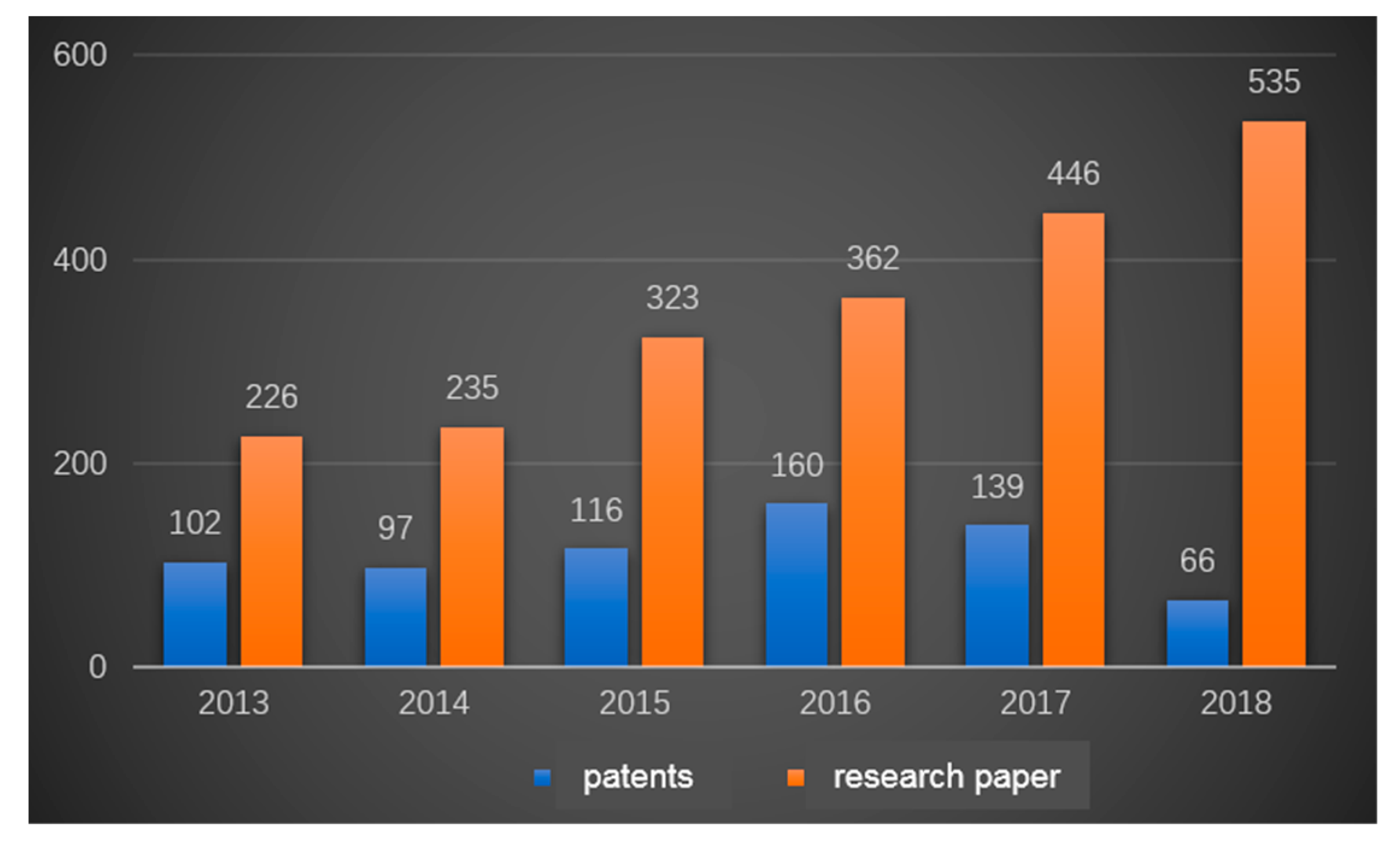
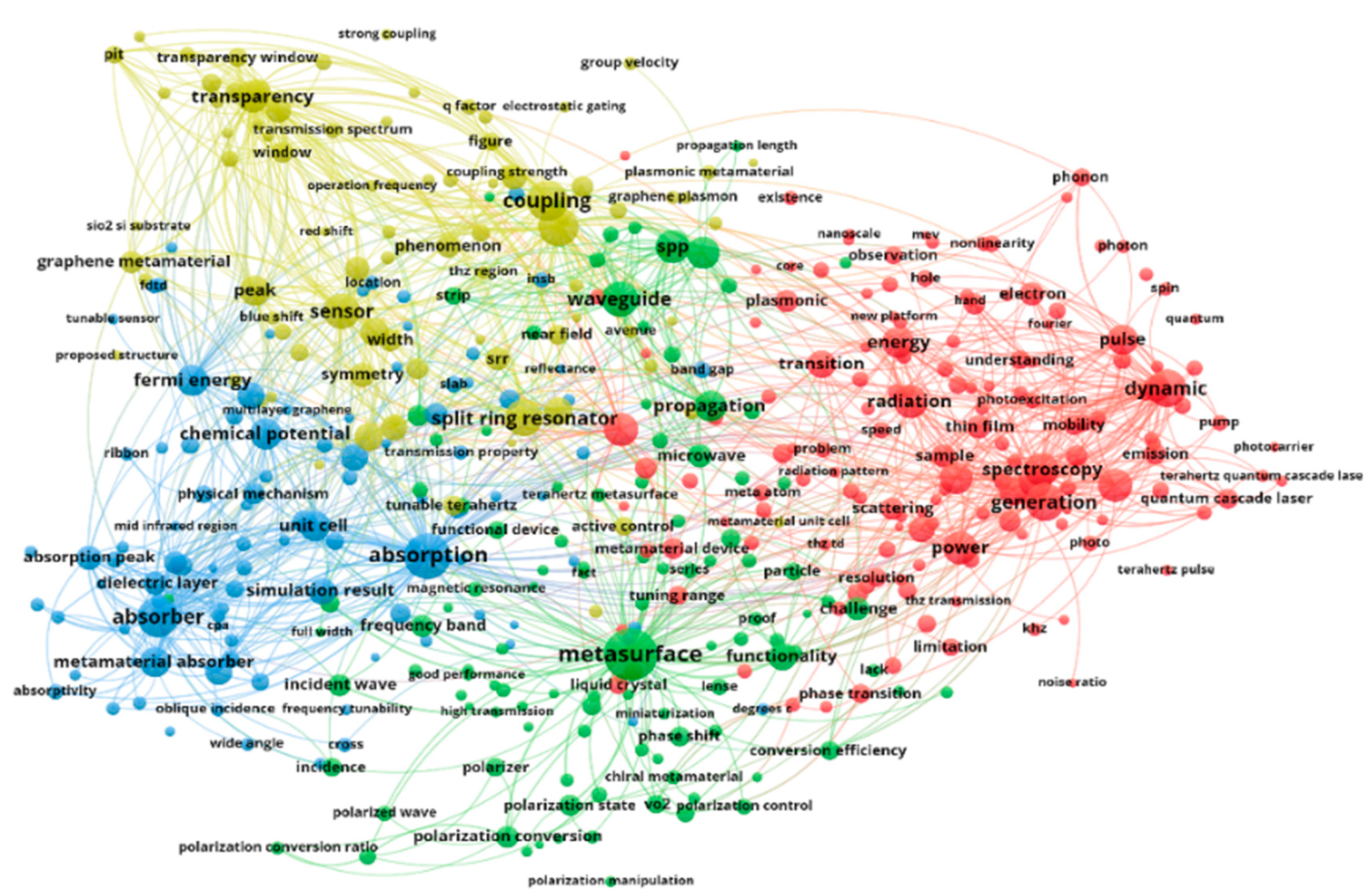
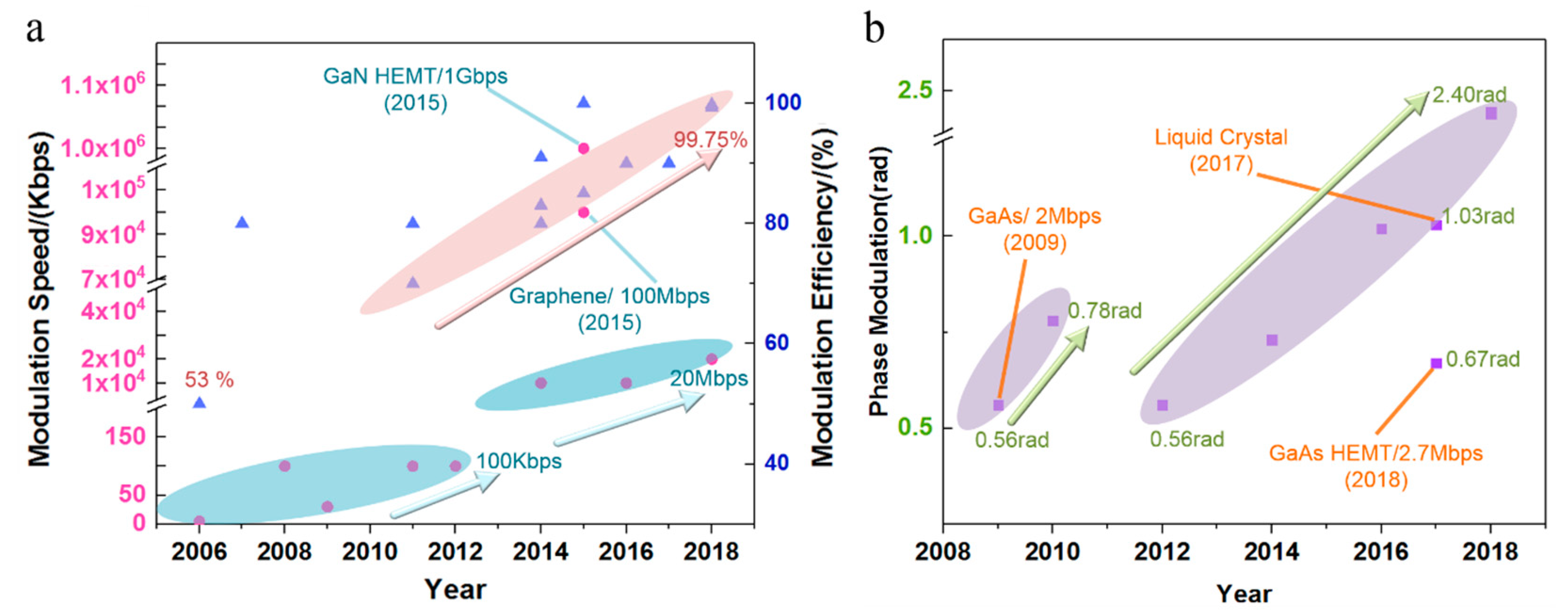
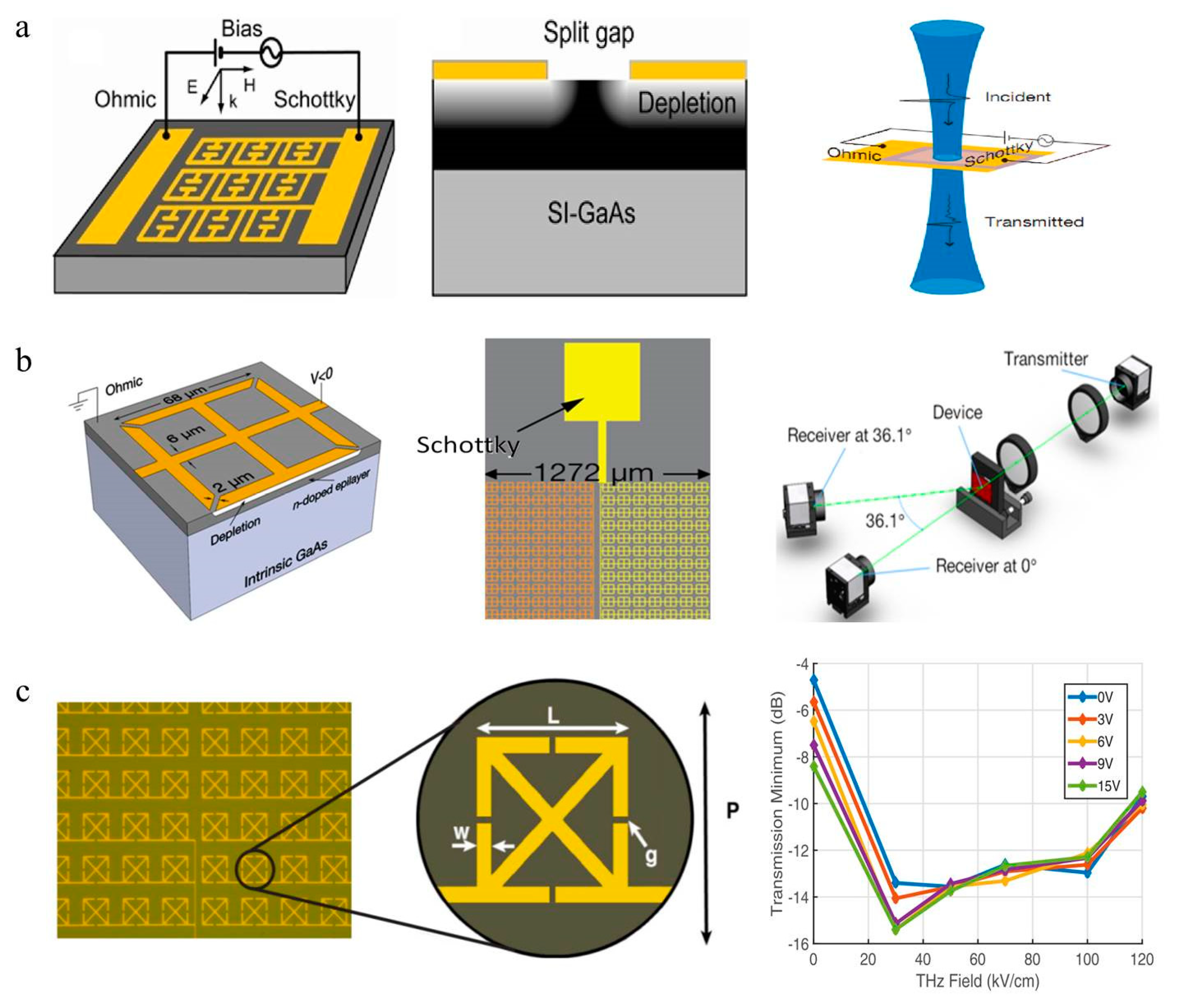
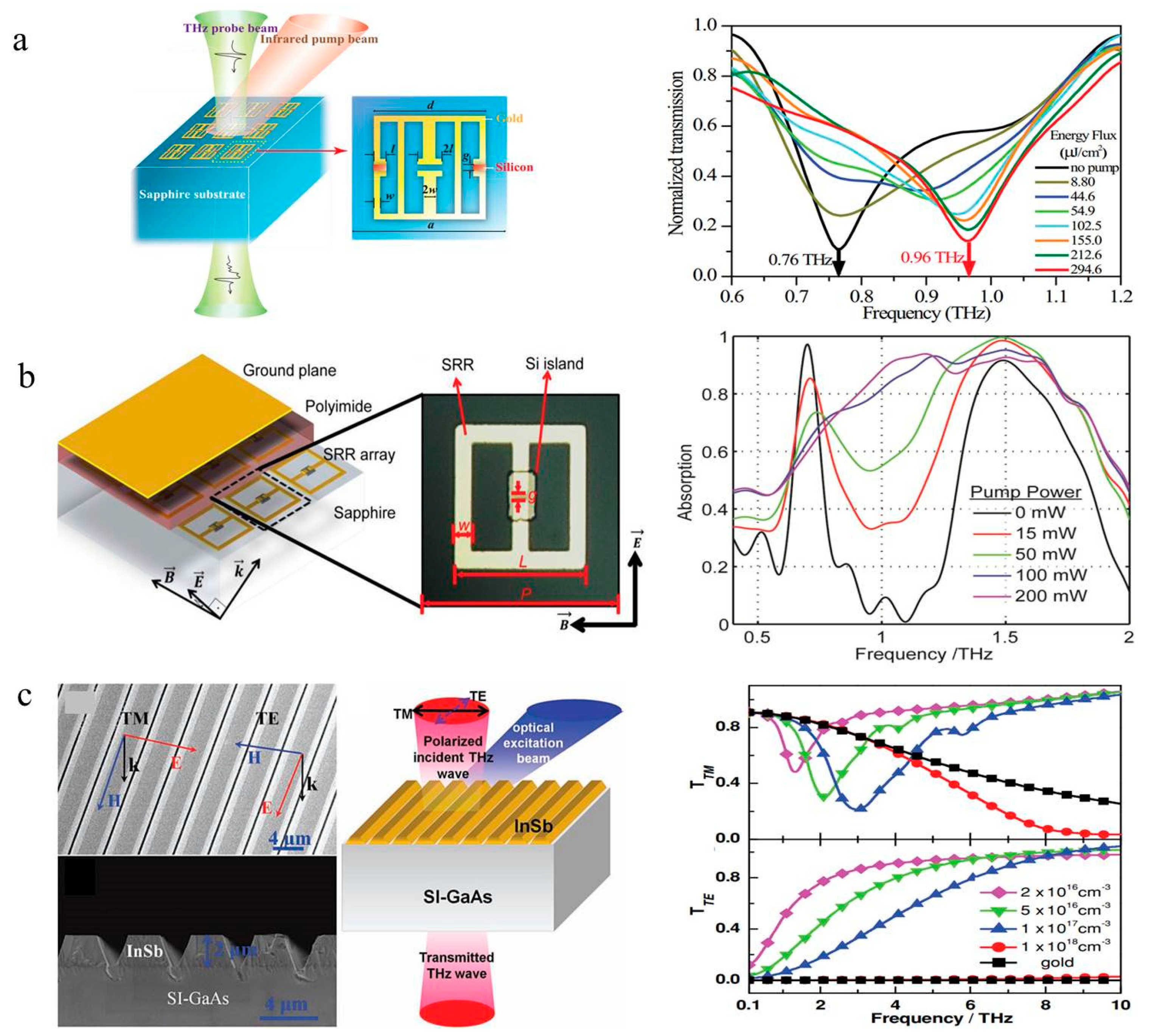
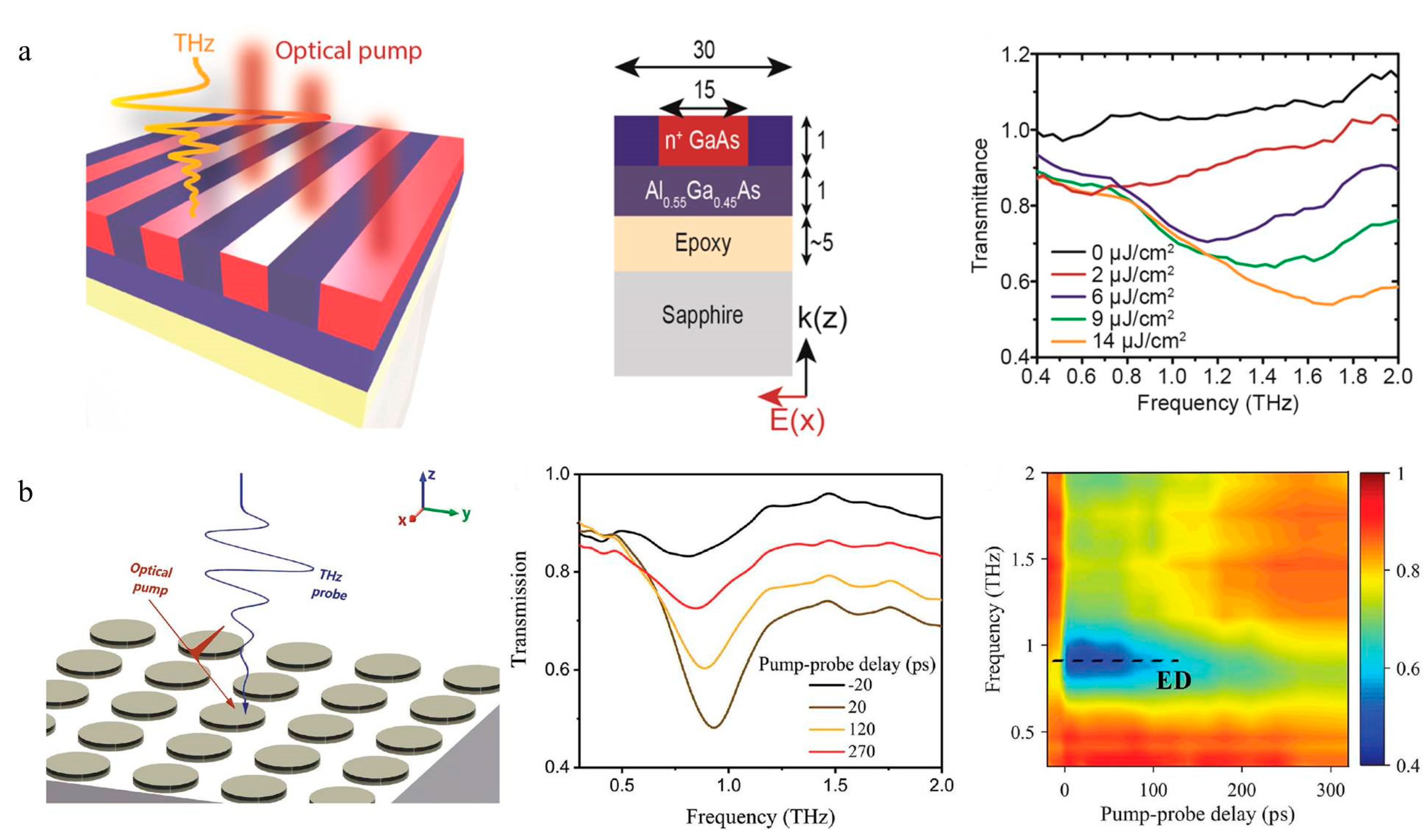
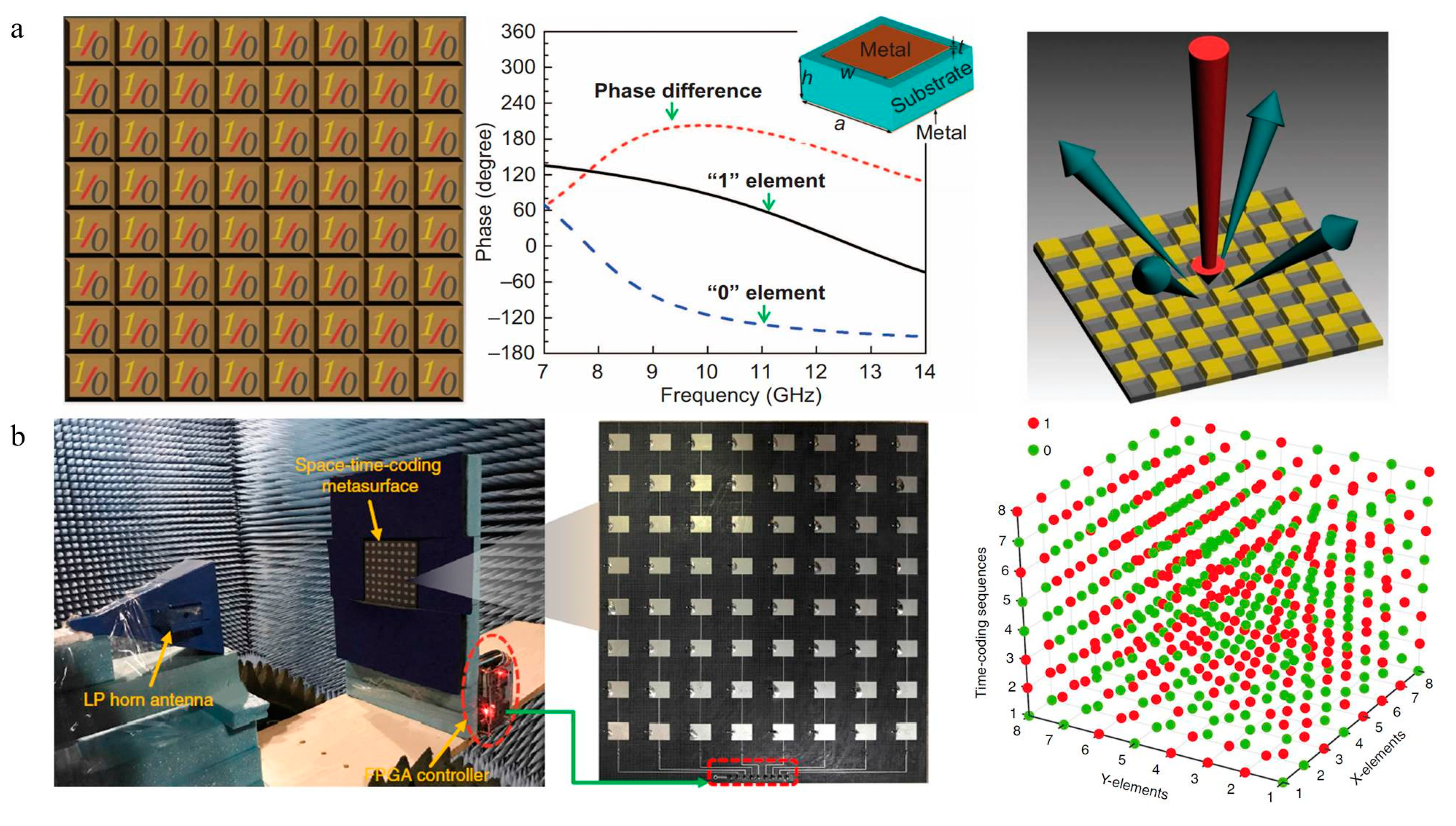
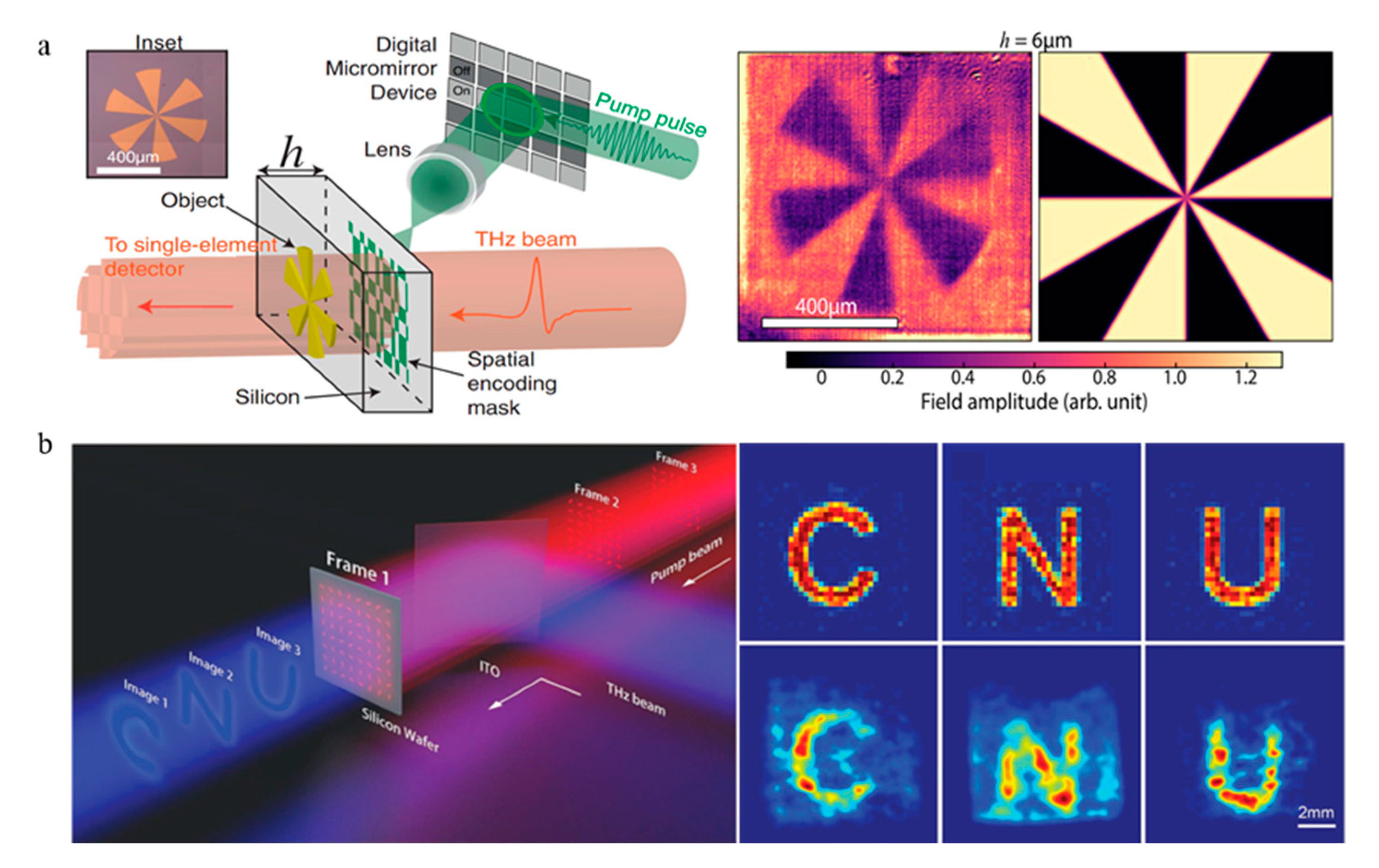

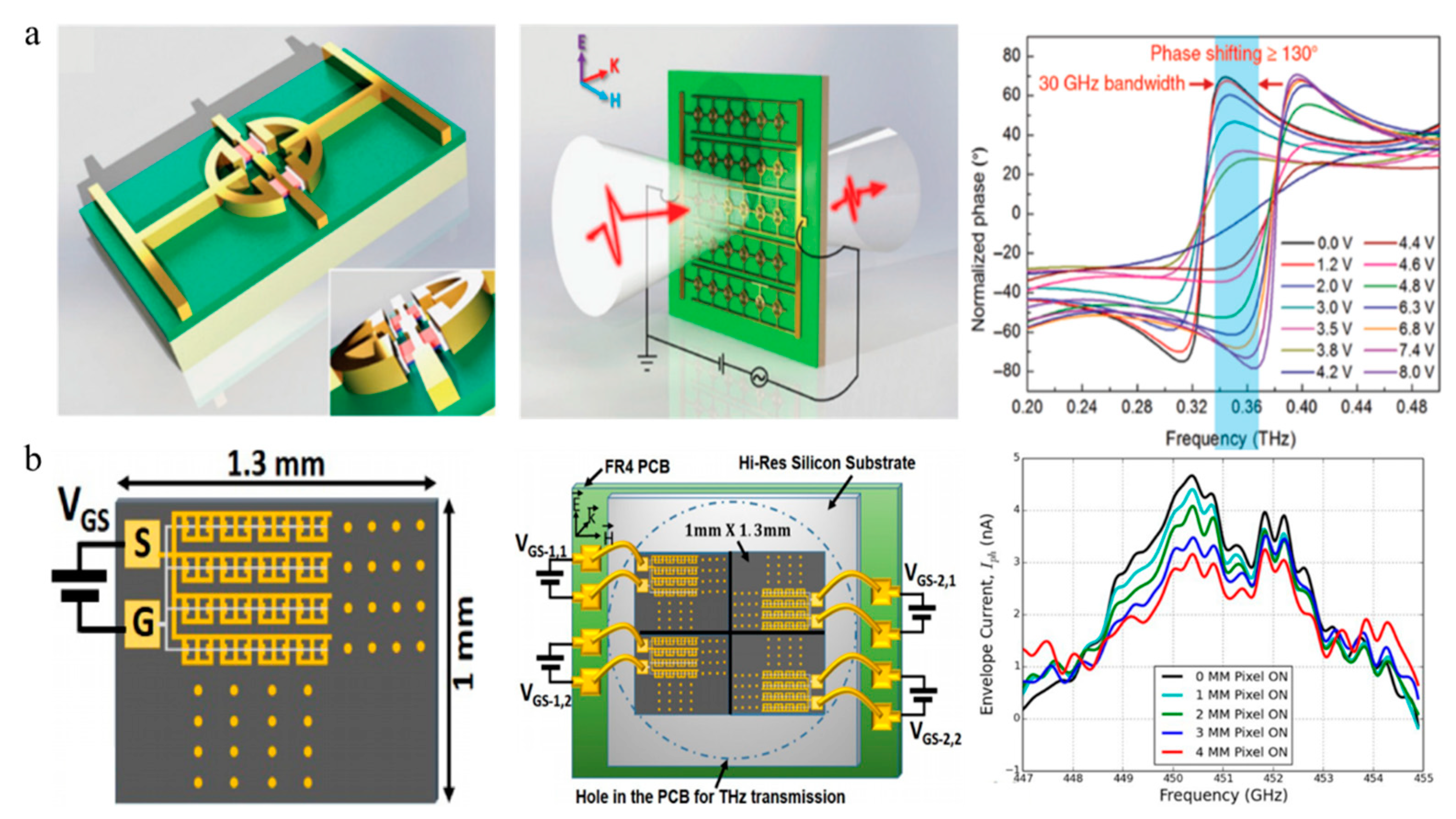
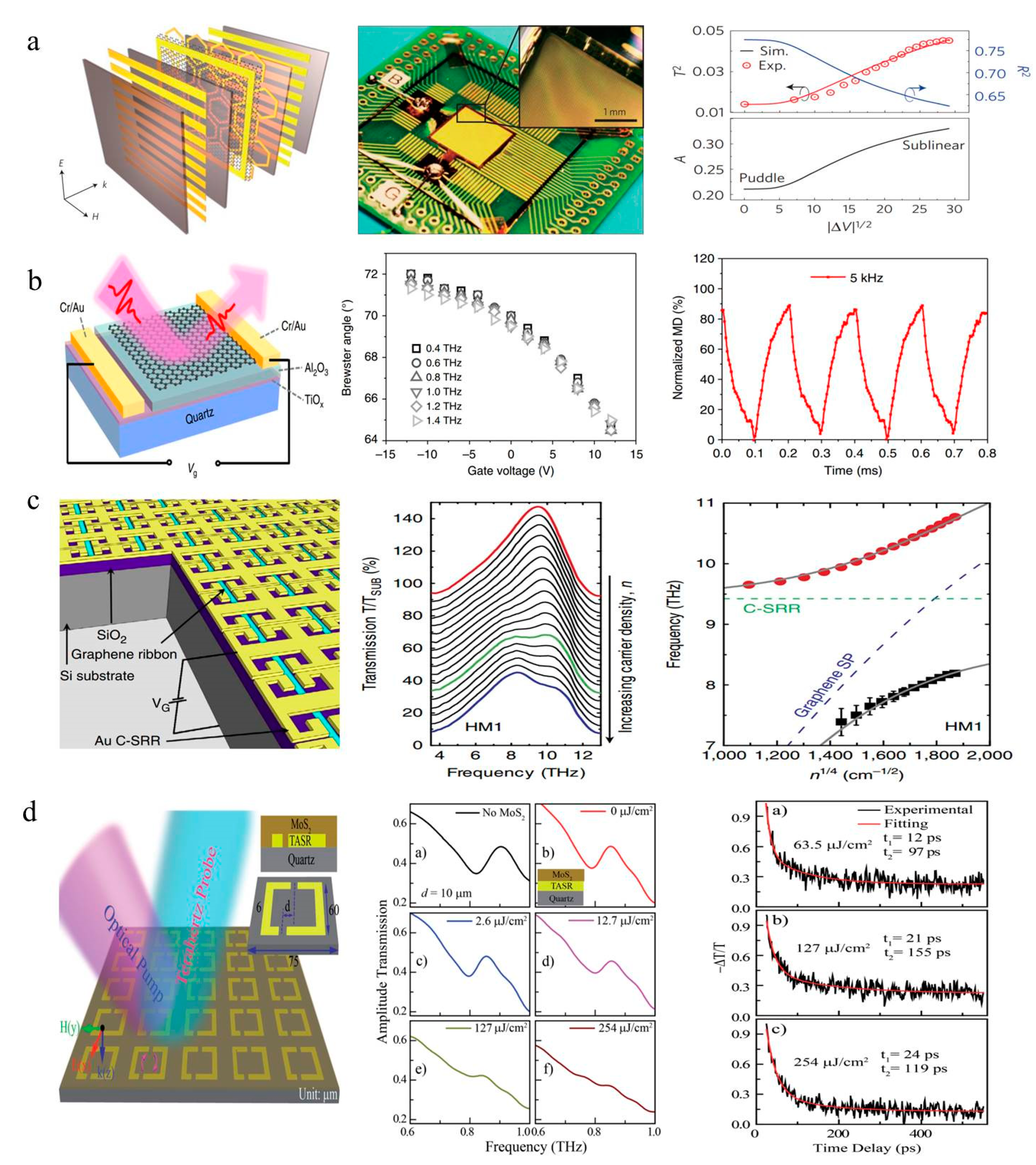

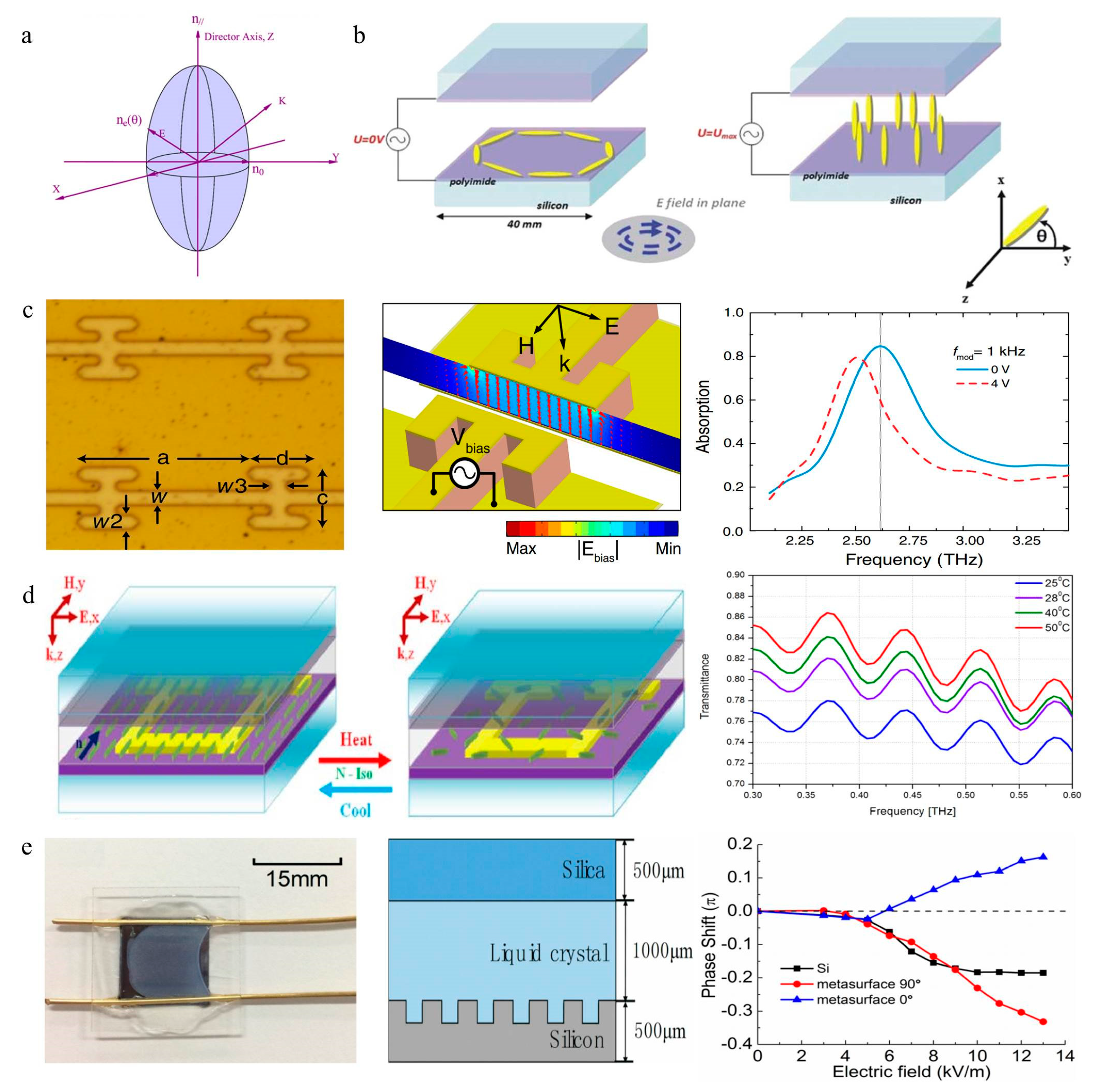


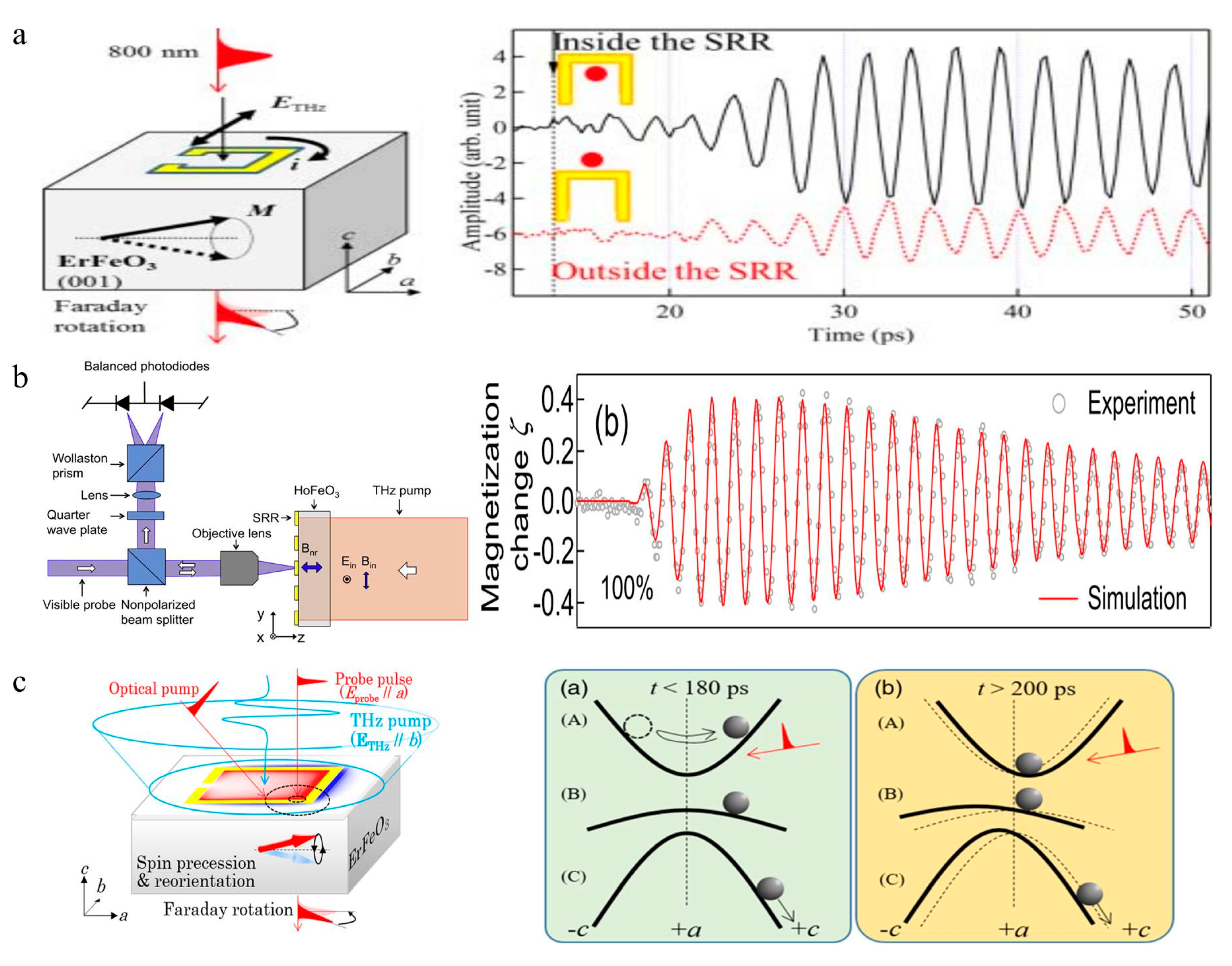
| Type | Material | Mod Speed or Response Time | Mod Depth | Ref. |
|---|---|---|---|---|
| EC MS | GaAs | 2 MHz | 55% | 2009 [9] |
| EC MS | GaAs | ps range | 100% | 2019 [10] |
| PI MS | Silicon | 20/300 ps | 50% | 2018 [11] |
| 2D MS | Graphene | 100 MHz | 25% | 2016 [12] |
| 2D MS | MoS2 | 100 ps | 100% | 2017 [13] |
| 2DEGs MS | GaN HEMT | 1 GHz | 85% | 2015 [14] |
| 2DEGs MS | GaAs HEMT | 2.7 MHz | 80% | 2017 [15] |
| VO2 MS | VO2 | 1 MHz | 88% | 2014 [16] |
| Liquid Crystal MS | Liquid Crystal | 50 ms | 100% | 2015 [17] |
| Liquid Crystal MS | Liquid Crystal | \ | 80% | 2017 [18] |
| Superconducting MS | YBCO | 80 ps | 86%/60% | 2018 [19] |
| Superconducting MS | NbN | 1 MHz | 79.8% | 2017 [20] |
| Spintronics MS | BaTiO3 | \ | 40% | 2017 [21] |
| Type | Material | Mod Speed | Phase Mod | Ref |
|---|---|---|---|---|
| EC MS | GaAs | >2 MHz | 0.56 rad | 2009 [9] |
| PI MS | GaAs | — | 0.78 rad | 2010 [22] |
| 2D MS | Graphene | 100 kHz | 0.56 rad | 2012 [23] |
| 2D MS | Graphene | 20 kHz | 0.73 rad | 2014 [24] |
| 2DEGs MS | GaAs HEMT | 2.7 MHz | 0.67 rad | 2017 [15] |
| 2DEGs MS | GaN HEMT | __ | 2.39 rad | 2018 [25] |
| VO2 MS | VO2 | — | 1.02 rad | 2016 [26] |
| VO2 MS | VO2 | __ | 2.41 rad | 2018 [27] |
| Liquid Crystal MS | Liquid crystal | __ | 1.03 rad | 2017 [28] |
© 2019 by the authors. Licensee MDPI, Basel, Switzerland. This article is an open access article distributed under the terms and conditions of the Creative Commons Attribution (CC BY) license (http://creativecommons.org/licenses/by/4.0/).
Share and Cite
Wang, L.; Zhang, Y.; Guo, X.; Chen, T.; Liang, H.; Hao, X.; Hou, X.; Kou, W.; Zhao, Y.; Zhou, T.; et al. A Review of THz Modulators with Dynamic Tunable Metasurfaces. Nanomaterials 2019, 9, 965. https://doi.org/10.3390/nano9070965
Wang L, Zhang Y, Guo X, Chen T, Liang H, Hao X, Hou X, Kou W, Zhao Y, Zhou T, et al. A Review of THz Modulators with Dynamic Tunable Metasurfaces. Nanomaterials. 2019; 9(7):965. https://doi.org/10.3390/nano9070965
Chicago/Turabian StyleWang, Lan, Yaxin Zhang, Xiaoqing Guo, Ting Chen, Huajie Liang, Xiaolin Hao, Xu Hou, Wei Kou, Yuncheng Zhao, Tianchi Zhou, and et al. 2019. "A Review of THz Modulators with Dynamic Tunable Metasurfaces" Nanomaterials 9, no. 7: 965. https://doi.org/10.3390/nano9070965
APA StyleWang, L., Zhang, Y., Guo, X., Chen, T., Liang, H., Hao, X., Hou, X., Kou, W., Zhao, Y., Zhou, T., Liang, S., & Yang, Z. (2019). A Review of THz Modulators with Dynamic Tunable Metasurfaces. Nanomaterials, 9(7), 965. https://doi.org/10.3390/nano9070965





